SEO
SEO Agency Software (What Do They Use?)

Here’s my selection of the software that SEO agencies use to get their work done and manage their teams successfully.
Accurate data is important for SEO agencies to make good decisions. As a result, every agency I’ve worked for over the past 10 years has had access to Ahrefs.
So when it comes to providing specific SEO services for clients, it mostly comes down to using the different Ahrefs tools.
Keyword research
Most agencies use Google Keyword Planner (GKP) or a tool like Ahrefs’ Keywords Explorer to do their keyword research.
GKP used to be considered the most accurate keyword tool because the data came from Google. These days, however, it’s probably not true.
Here’s why.
Firstly, GKP no longer shows exact search volumes—it only shows a range.
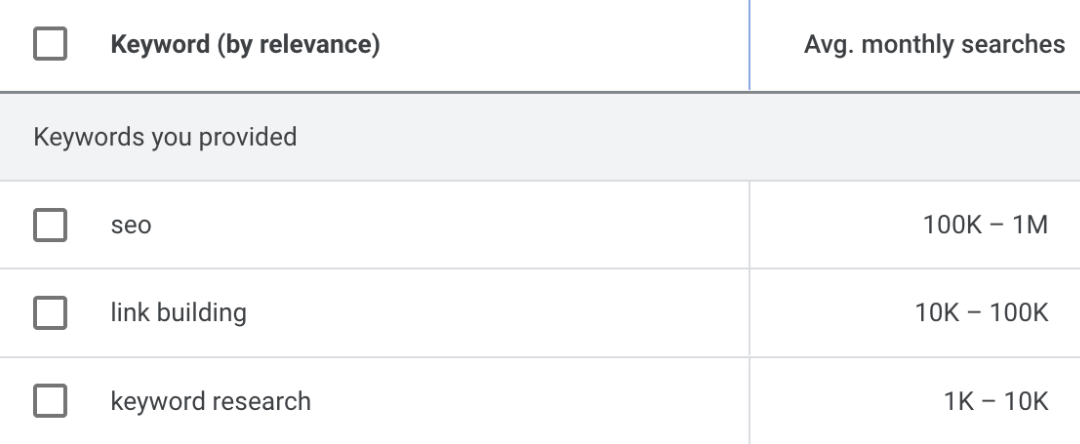
Whereas, Ahrefs gives a more definitive answer in terms of volume, which is more helpful for agencies planning an SEO campaign.
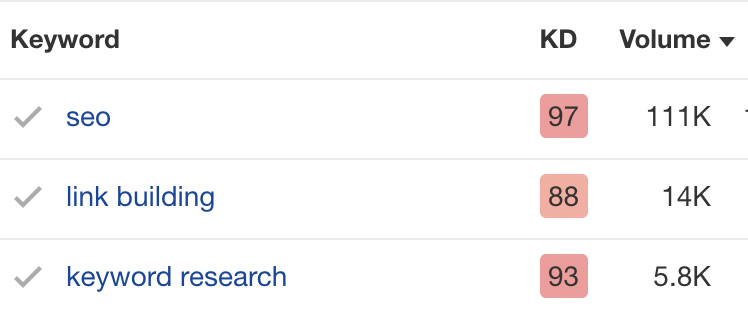
Secondly, Ahrefs CMO Tim Soulo’s GKP study suggested that GKP data is overestimated.

It’s why many agencies have switched to third-party tools like Ahrefs’ Keywords Explorer to do their keyword research.
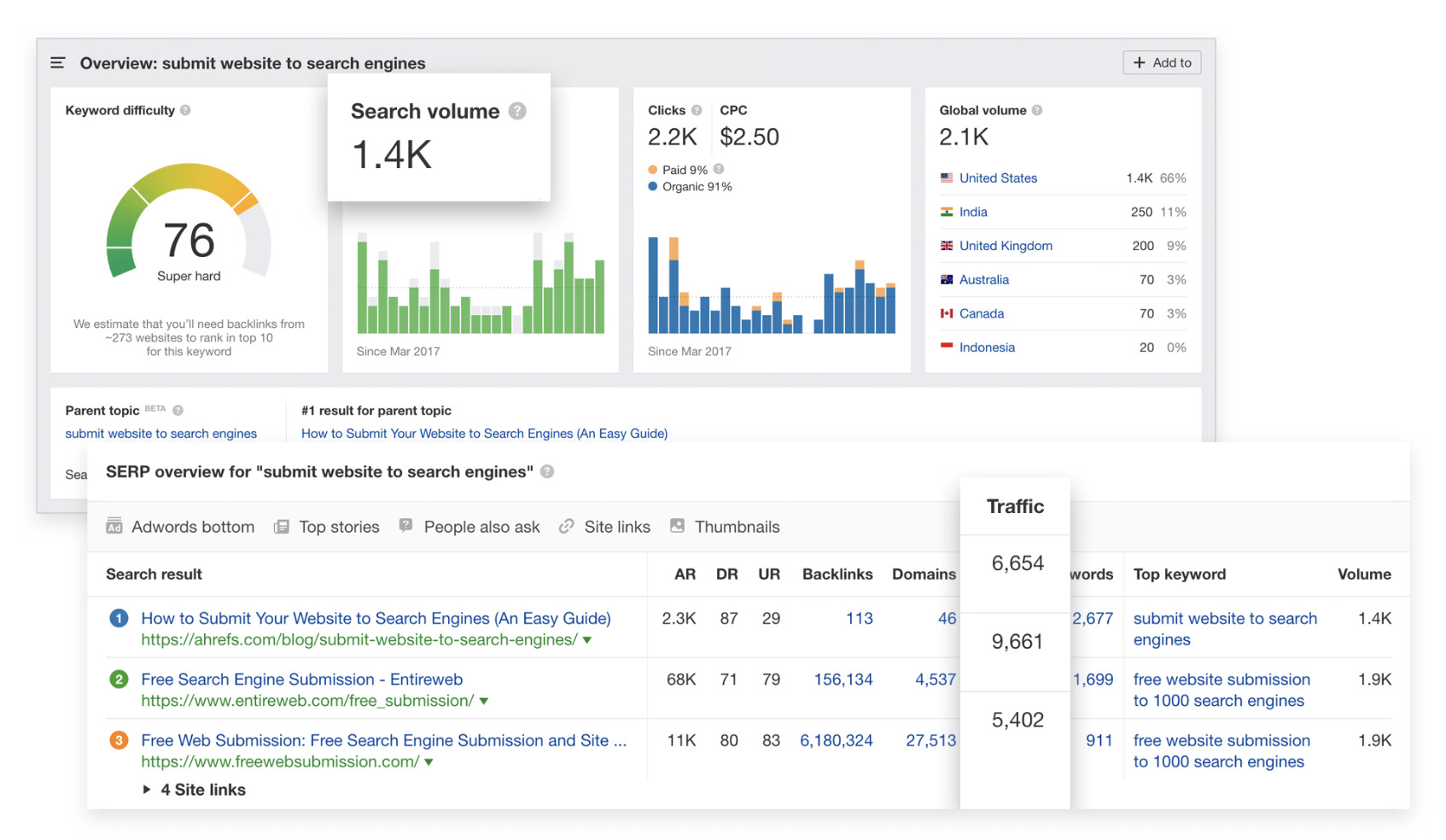
Generally speaking, tools like this can provide a helpful representation of what’s happening in the search results.
Competitor analysis
Each agency has its methods for completing a competitor analysis. But there is one common denominator that most agencies will agree on—speed.
With multiple clients contacting you at all times during the working day, agency workers must understand a competitor’s SEO strategy. They then need to share it at a moment’s notice with the client.
To get a bird’s-eye view of the competitor landscape, you can use a tool like Ahrefs’ Site Explorer.
Simply plug a domain into Site Explorer and head to the Organic competitors report.

This tool lets you quickly identify the top five organic competitors for the domain entered and shows you their value plotted against their traffic.
Once you’ve identified your top competitors, you can analyze them further by scrolling down to the Top competing domains report to get into the details.
Another quick method to analyze your competitors’ websites is to use Ahrefs’ SEO Toolbar to get an overview of each competitor and jot a few notes down about each site.
Here’s an example of me looking at the Nasty Gal homepage using the toolbar.

From here, you can understand the state of the competitor’s SEO and also use Site Explorer and Keywords Explorer to dig deeper into the details.
Once the agency has enough information about the competitors, it’ll typically present its findings in a PowerPoint format.
Rank tracking
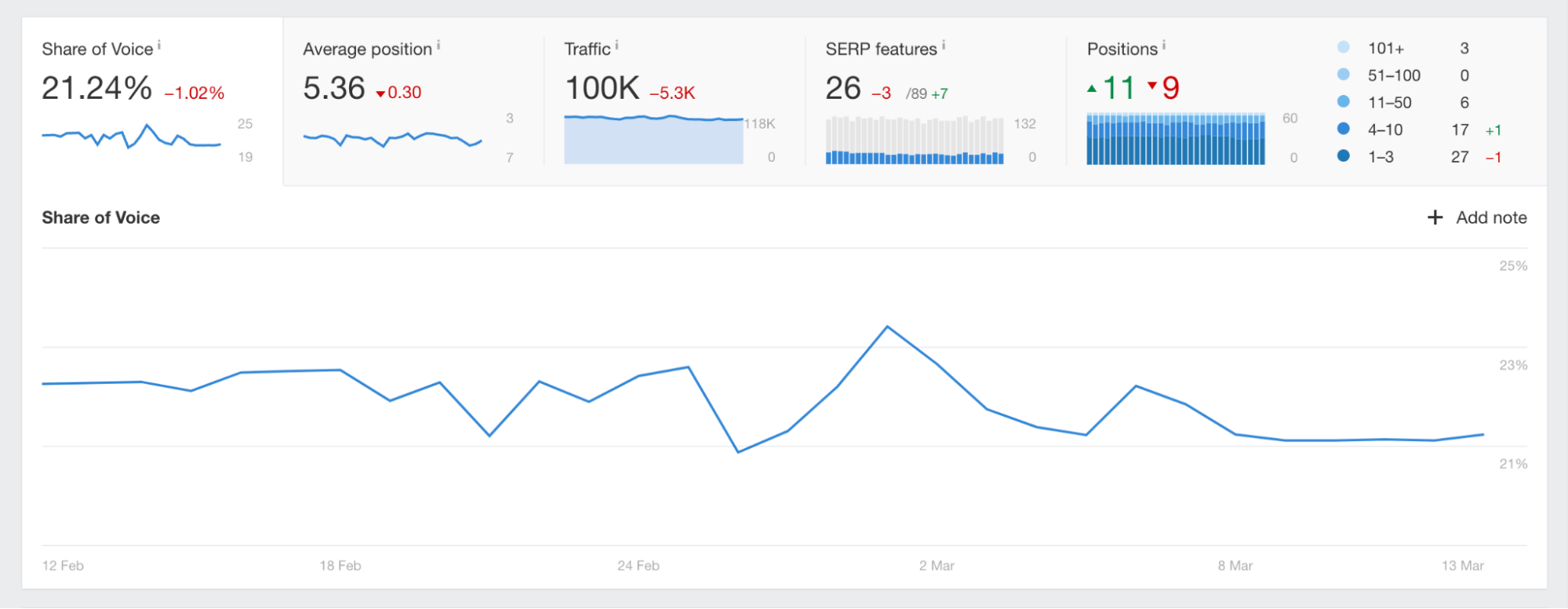
SEO agencies also need to prove results, and the primary way they do this is by tracking a client’s keywords and Google rankings.
This often means tracking hundreds or even thousands of keywords and organizing them logically. But how can you do this?
You’ll need to use a software tool like Ahrefs’ Rank Tracker to do it effectively.
Rank Tracker can help you monitor several key performance indicators, such as:
- Share of voice
- Average position
- Organic traffic
- SERP features
- Positions
Monitoring these data points helps you understand the impact of any Google updates as well as the performance of your website.
SEO audits and SEO proposals
Most agencies audit a prospective client’s site before working with them, so they can show the client what SEO issues are on the website and suggest fixes.
Although you can manually audit their site, it isn’t an efficient use of time.
Therefore, many agencies use a tool like Ahrefs’ Site Audit to quickly get to the core of a website’s SEO issues.

Here’s an example of the types of issues the tool can find:
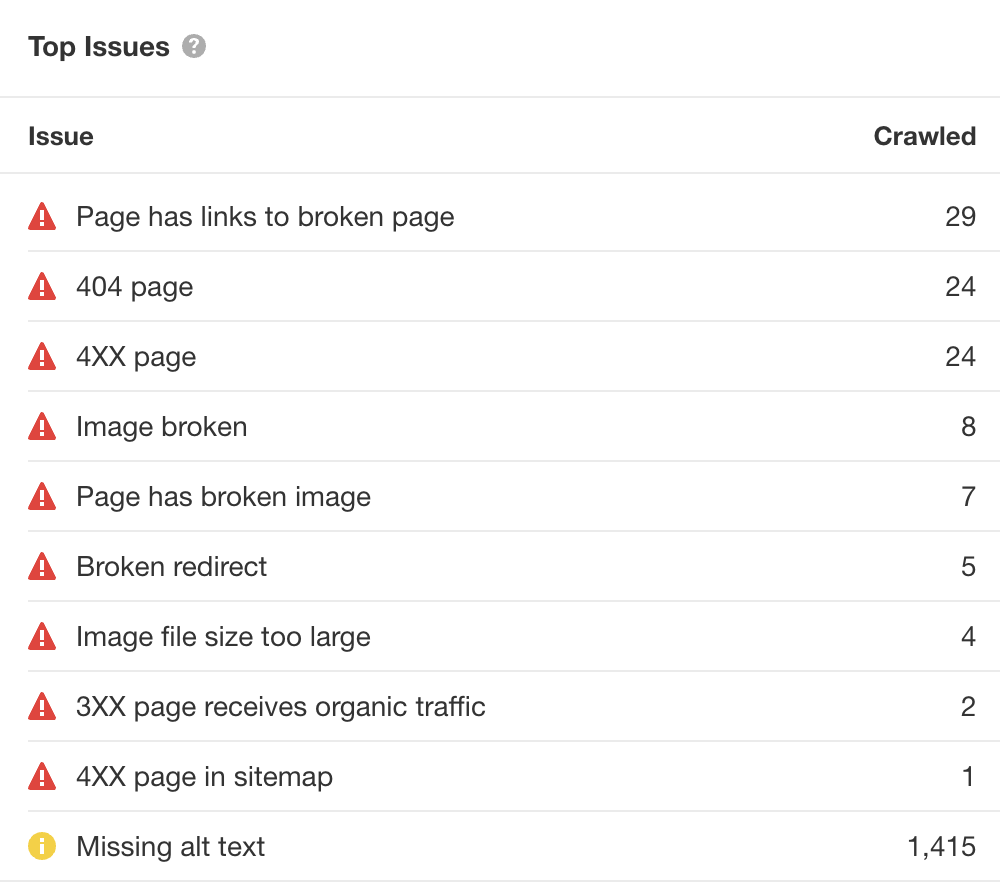
This type of technical analysis overview is a good starting point for fixing the issues on your client’s website.
Link building
When it comes to link building, agencies usually focus on creating a stand-out piece of content for a client that will help them acquire links naturally.
This content could be new research, a survey, or anything else the agency feels would accrue links over time.
Once it has made the content, it starts the outreach process—to spread awareness of the work.
To contact the relevant websites, it will typically use one of two tools:
- BuzzStream – The first outreach tool I used in my agency career. It covers link prospecting, creating custom email templates, organizing contacts, and managing the outreach process.
- Pitchbox – A popular alternative to BuzzStream that has testimonials from several well-known SEOs. Features are tailored toward agencies.
An SEO professional’s main objective is to rank websites in Google search, so it’s natural they’ll use several Google software products to understand their performance in the search engine.
Here’s my rundown of the top Google software SEO agencies typically use:
Google Analytics
Google Analytics (GA) is relatively ubiquitous in the agency-client world.
It’s usually the first place SEO agencies go to when they want to gauge the amount of traffic their clients’ websites have.
Google Search Console
Google Search Console is another popular tool SEOs in agencies use to gauge performance.
It allows you to:
- View how often your site appears in Google Search and which search queries it shows for, and how often searchers click through for those queries.
- Get a breakdown of websites that link to your site.
- See if Google can find and crawl your site.
- Fix indexing problems and request reindexing of new or updated content.
- Receive alerts when Google encounters issues on your site.
Google Looker Studio (formerly known as Google Data Studio)
Like rank tracking, reporting on the progress of your SEO campaign is important for agencies of all sizes.
Tools like Google Looker Studio (GLS) allow them to do several things:
- Aggregate multiple data sets – GA, GSC, and Ahrefs data can be integrated into one dashboard.
- Create scheduled reports – Schedule PDF reports to be sent to them and other stakeholders.
Check out our Data Studio documentation for more information on setting up the Ahrefs integration.
Google Trends
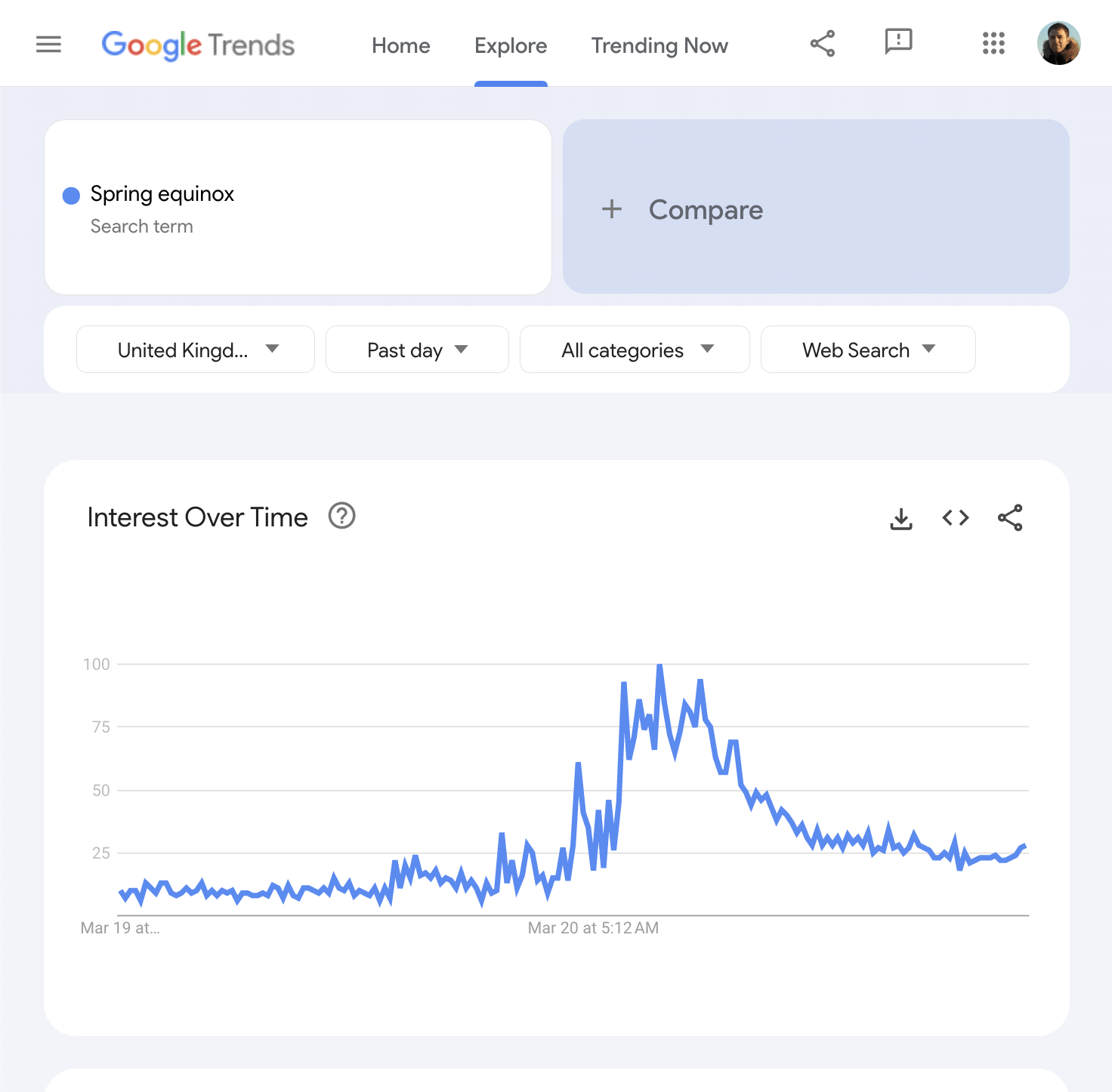
Every keyword you search for in Google has a search trend. Agencies will spot-check these trends by typing them into Google Trends. It helps to give an idea of whether a keyword is worth targeting.
Agencies use Google Trends to visualize specific keywords’ rising or diminishing popularity.
Google Colaboratory

Google Colaboratory (Collab) is one of the tools that SEOs use to run Python scripts.
Although you can run Python code in different ways, getting sign-off to run Python on your work laptop is often more trouble than it’s worth.
Using a third-party tool like Collab enables you to bypass this restriction (in most cases) and run your favorite Python scripts, increasing your efficiency and automating the mundane.
Google PageSpeed Insights

Site speed has been a hot topic for a few years now. Google estimated that for every one-second delay in mobile page load, conversions could fall up to 20%.
One of the tools agency SEOs use to measure page speed and Core Web Vitals is Google PageSpeed Insights.
There are other tools agencies use, such as:
- Webpagetest.org – Great for comparing site speed vs. competitors’.
- GTmetrix – Good all-around tool for checking site speed.
With so many SEO Chrome extensions, it’s hard to know which ones to use. These are the extensions most shared in agencies I’ve worked in.
It may seem unconventional that agencies use free Chrome extensions, but it comes back to speed.
These types of extensions help you to identify issues quickly. You can always return to the issues later for further analysis if needed.
Chrome DevTools

Chrome DevTools is another useful tool for most agency SEOs that’s worth taking a look at.
Although extensions, plugins, and software can help you spot-check the data quickly, you need to go into the code to understand what is happening. This is where Chrome DevTools can be really useful.
As agencies use various tools, they often dream of simplifying their tool setups into one single platform. Several “middle-ware” solutions can help you achieve this:
Supermetrics
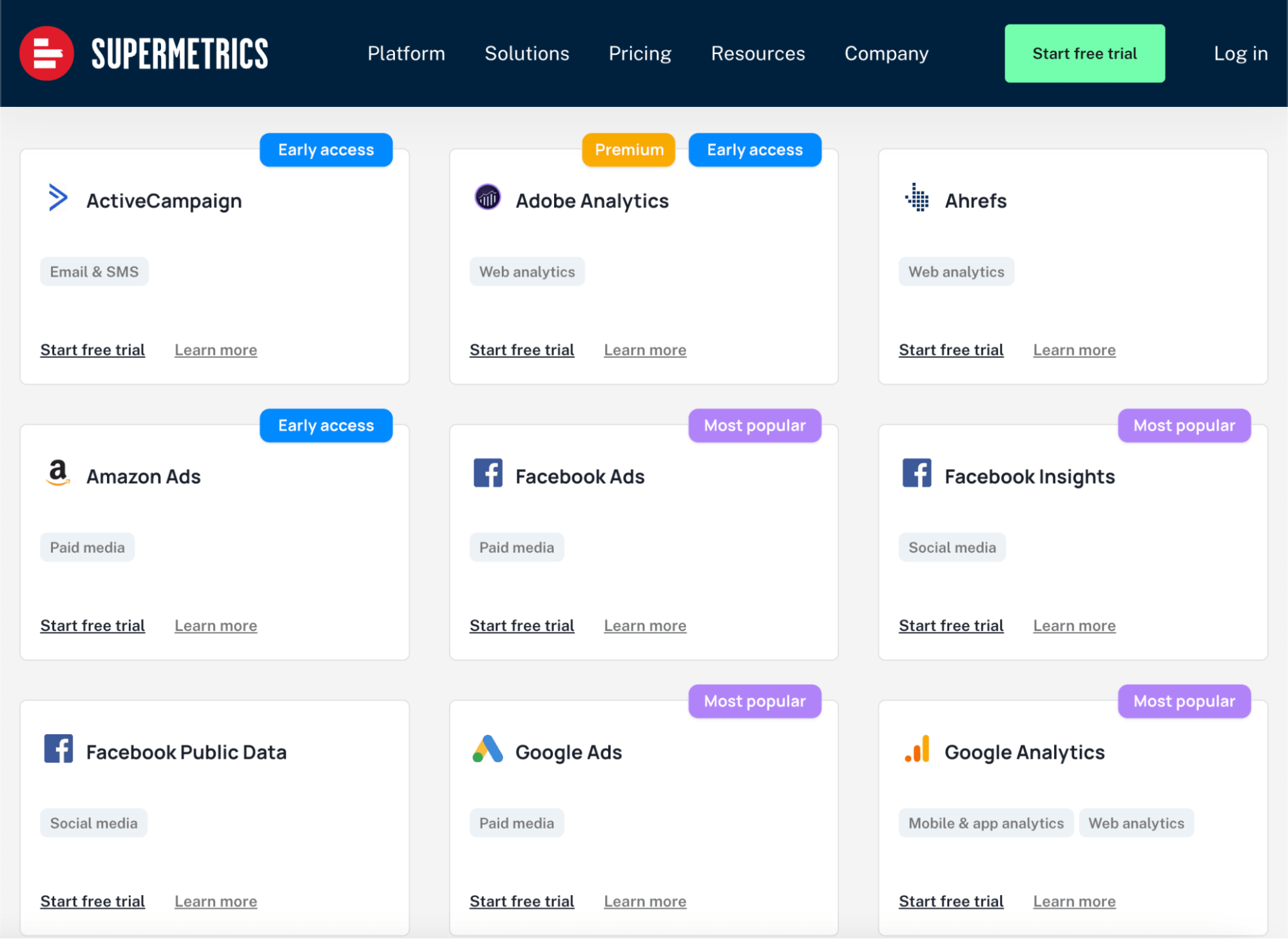
Supermetrics is a paid software tool that allows you to integrate data from 100+ platforms together. This enables you to increase your agency’s efficiency—specifically with SEO reporting.
Zapier
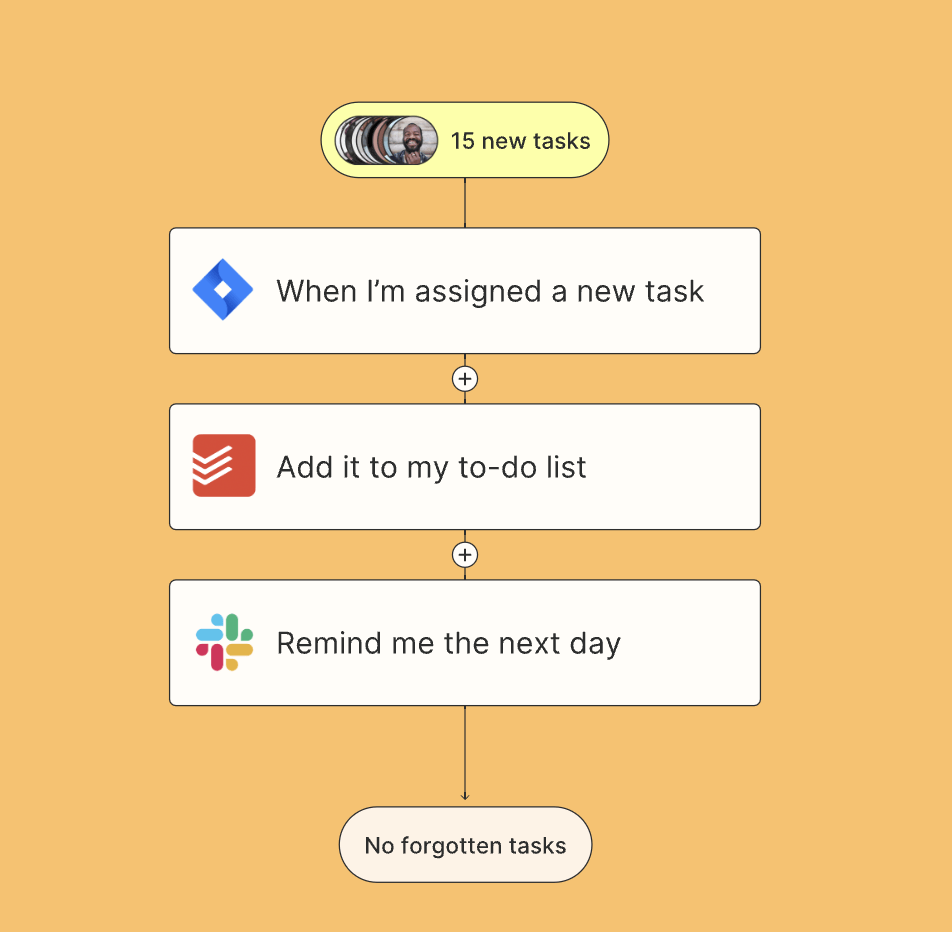
Zapier is another useful tool that automates interactions between different software tools.
This is particularly useful for automating repetitive tasks. Another benefit is that it is a no-code tool, so you don’t need any development experience to set up the automation.
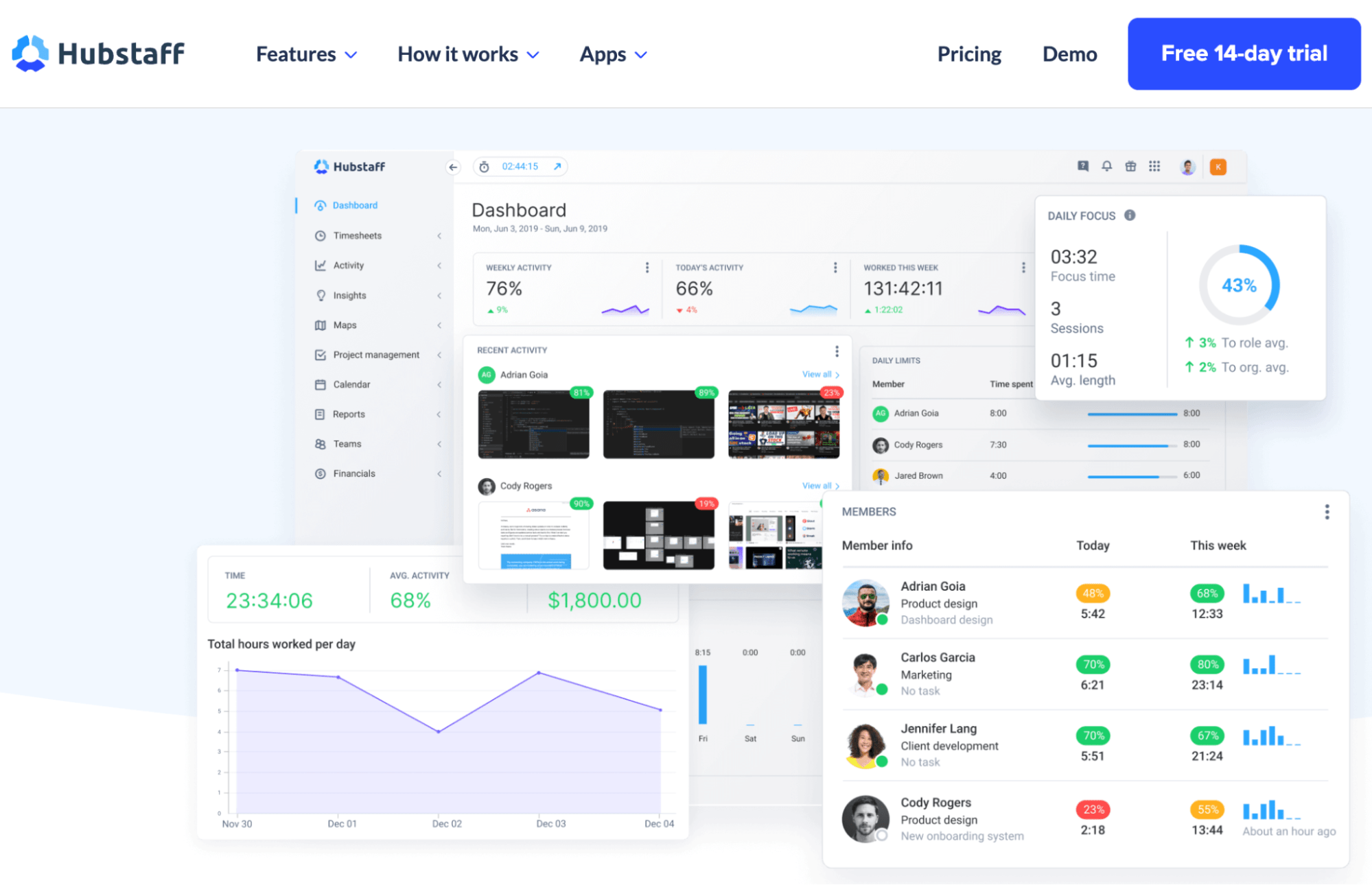
As an SEO agency, you and your team must keep track of your time.
Every agency I’ve worked at has used a different time-tracking tool, and there doesn’t seem to be much consensus on which is the “best one.”
So here are a few examples of time-tracking software I’ve used in agencies:
- Hubstaff – A great all-around time-tracking system.
- Toggl – Popular with smaller agencies.
- Timeneye – A simple and easy-to-use time tracker.
- SAP – Comprehensive time-tracking solution.
The most efficient SEO teams will have their methods to organize and distribute tasks among their team members.
Although you can do this in a humble spreadsheet, software tools can help.
All of the below are great, and I have seen them used in agencies effectively.
- Trello – Basic Kanban board functionality with simple and effective project management.
- ClickUp – Useful to keep your team on track with progress and break down tasks.
- Monday – Easy-to-use task management tool with no-code automation built in.
- Confluence – Team workspace useful for agencies working with clients to track progress on shared goals.
- Basecamp – One of the easiest-to-use task management platforms around.
SEO agencies have lots of clients, and the reality is they will all have their preferred method of getting in contact with you.
Microsoft Teams
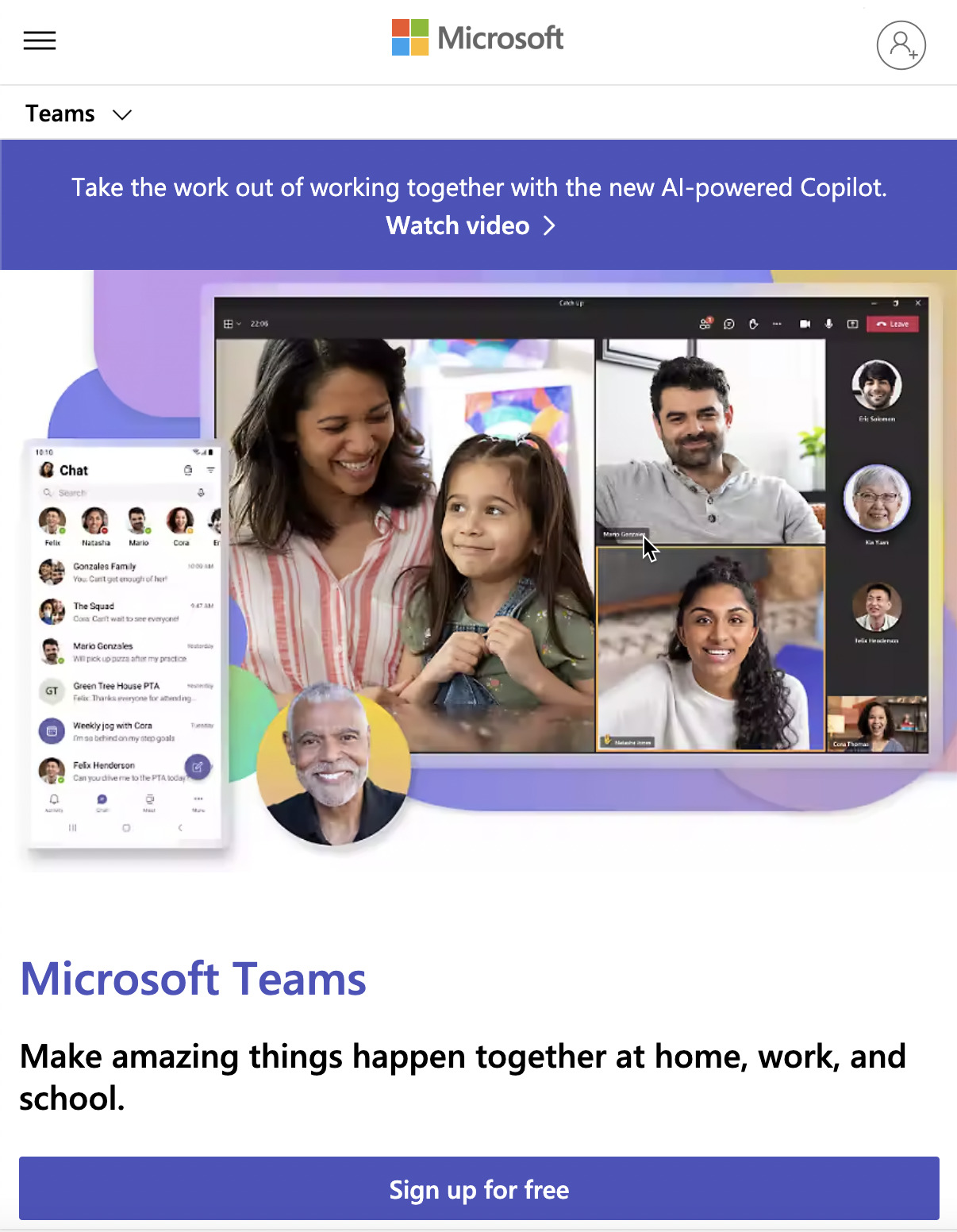
When it comes to remote meetings, Microsoft Teams is the de facto standard for SEO agencies in terms of client-agency communication.
This is because signing off on a Microsoft product with the IT department in most agencies is generally much easier.

The most used software suite by far for agency SEOs is Microsoft Office (now known as Microsoft 365).
Yes—it’s not the most exciting piece of software. But it’s been a constant presence throughout my agency career.
The key products SEO agencies use in Microsoft 365 are:
- Microsoft Outlook – Send and receive emails.
- Microsoft Excel – Analyze data from your SEO campaigns.
- Microsoft Word – Prepare documents for your SEO campaigns.
- Microsoft PowerPoint – Create presentations, reports, and pitch decks for your clients or prospective clients.
If you are working with clients, they’ll expect you to have access to this software.
Sidenote.
Google offers software that mirrors the functionality of Microsoft 365 for free. There is nothing wrong with the Google software option. But on the whole, agencies still prefer to use Microsoft 365.
Working with freelancers in an agency setting is becoming more common. You can manage them through day-to-day task management and existing HR tools, but some agencies prefer to keep them separate.
If you are working with freelancers at scale, you may need a platform to manage them.
Lano
Tools like Lano enable you to manage freelancers, e.g., allowing you to pay your remote contractors easily.

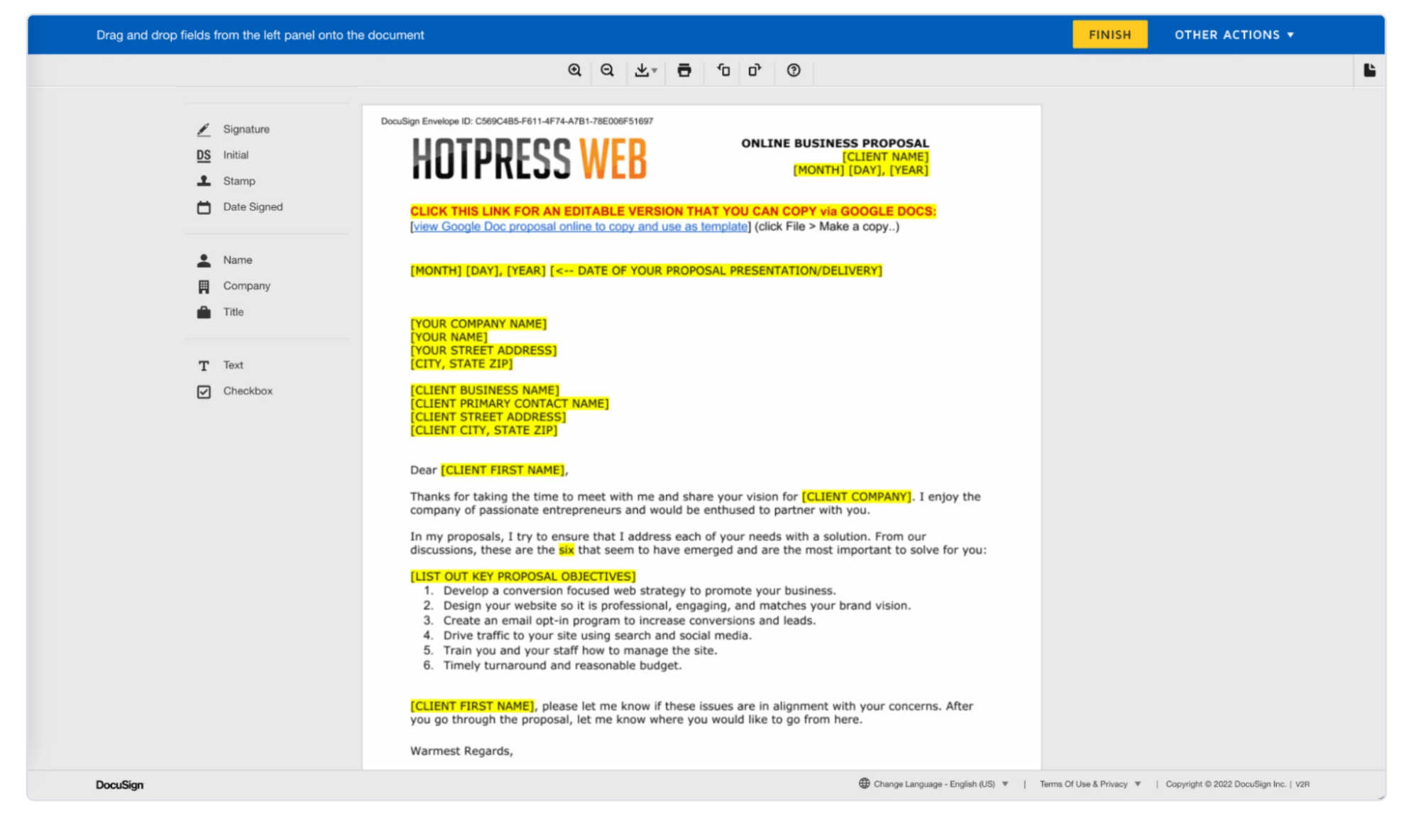
Once your agency has won a new client, you must create a contract and set a recurring billing schedule.
Here’s how agencies of different sizes approach it:
Many of the larger agencies will use purchase orders (POs). In the past, I’ve used tools such as Mediaocean’s Prisma to book these in.
For smaller agencies, it’s more likely they’ll use something like DocuSign or Stripe, but every agency will have its preferred methods.
Final thoughts
Access to the best software is vital for agencies; without this, they can’t advise their clients effectively and efficiently.
Got questions? Ping me on Twitter 🙂
SEO
Google Defends Lack Of Communication Around Search Updates

While Google informs the public about broad core algorithm updates, it doesn’t announce every minor change or tweak, according to Google’s Search Liaison Danny Sullivan.
The comments were in response to Glenn Gabe’s question about why Google doesn’t provide information about volatility following the March core update.
OK, I love that Google informs us about broad core updates rolling out, but why not also explain when huge changes roll out that seem like an extension of the broad core update? I mean, it’s cool that Google can decouple algorithms from broad core updates and run them separately… https://t.co/2Oan7X6FTk
— Glenn Gabe (@glenngabe) May 9, 2024
Gabe wrote:
“… when site owners think a major update is done, they are not expecting crazy volatility that sometimes completely reverses what happened with the major update.
The impact from whatever rolled out on 5/3 and now 5/8 into 5/9 has been strong.”
Sullivan explained that Google continuously updates its search ranking systems, with around 5,000 updates per year across different algorithms and components.
Many of these are minor adjustments that would go unnoticed, Sullivan says:
“If we were giving notice about all the ranking system updates we do, it would be like this:
Hi. It’s 1:14pm — we just did an update to system 112!
Hi. It’s 2:26pm — we just did an update to system 34!That’s because we do around 5,000 updates per year.”
This is covered on our long-standing page about core updates: https://t.co/Jsq1P236ff
“We’re constantly making updates to our search algorithms, including smaller core updates. We don’t announce all of these because they’re generally not widely noticeable. Still, when released,…
— Google SearchLiaison (@searchliaison) May 9, 2024
While Google may consider these minor changes, combining thousands of those tweaks can lead to significant shifts in rankings and traffic that sites need help understanding.
More open communication from Google could go a long way.
Ongoing Shifts From Web Changes
Beyond algorithm adjustments, Sullivan noted that search results can fluctuate due to the nature of web content.
Google’s ranking systems continually process new information, Sullivan explains:
“… already launched and existing systems aren’t themselves being updated in how they operate, but the information they’re processing isn’t static but instead is constantly changing.”
Google focuses communications on major updates versus a never-ending stream of notifications about minor changes.
Sullivan continues:
“This type of constant ‘hey, we did an update’ notification stuff probably isn’t really that useful to creators. There’s nothing to ‘do’ with those types of updates.”
Why SEJ Cares
Understanding that Google Search is an ever-evolving platform is vital for businesses and publishers that rely on search traffic.
It reiterates the need for a long-term SEO strategy focused on delivering high-quality, relevant content rather than reacting to individual algorithm updates.
However, we realize Google’s approach to announcing updates can leave businesses scrambling to keep up with ranking movements.
More insight into these changes would be valuable for many.
How This Can Help You
Knowing that Google processes new information in addition to algorithm changes, you may have more realistic expectations post-core updates.
Instead of assuming stability after a major update, anticipate fluctuations as Google’s systems adapt to new web data.
Featured Image: Aerial Film Studio/Shutterstock
SEO
How to Use Keywords for SEO: The Complete Beginner’s Guide
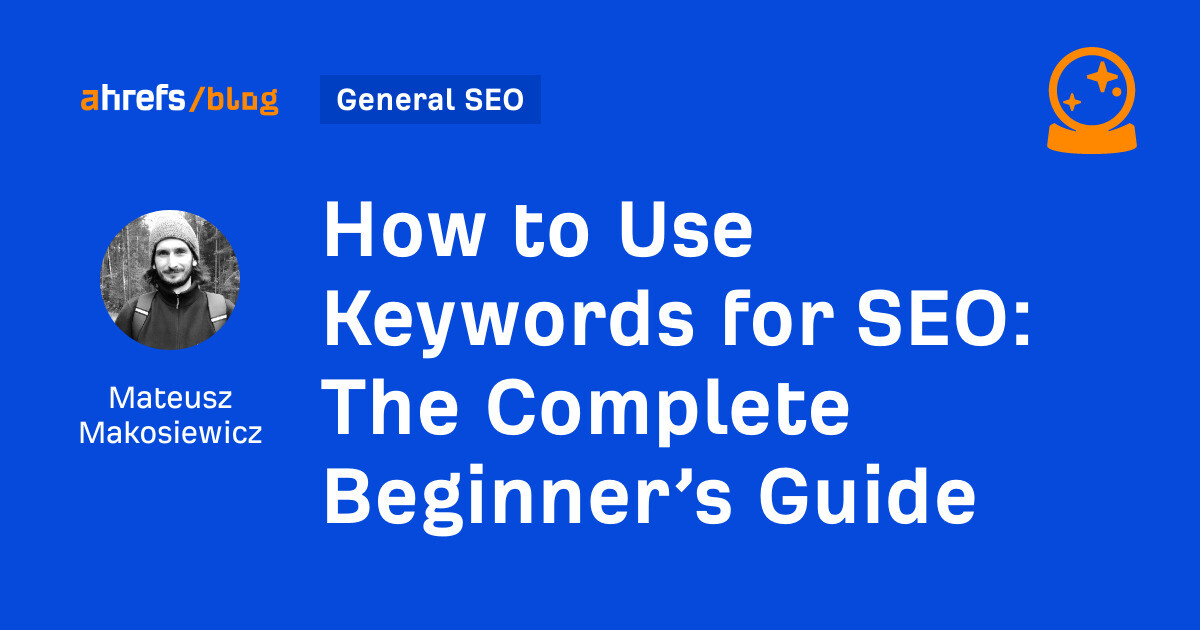
In this guide, I’ll cover in detail how to make the best use of keywords in three steps:
- Finding good keywords: keywords that are rankable and bring value to your site.
- Using keywords in content and meta tags: how to use the target keyword to structure and write content that will satisfy readers and send relevance signals to search engines.
- Tracking keywords: monitoring your (and your competitors’) performance.
There’s really a lot you can do with just a single keyword, so at the end of the article, you’ll find a few advanced SEO tips.
Once you know how to find one good keyword, you will be able to create an entire list of keywords.
1. Pick relevant seed keywords to generate keyword ideas
Seed keywords are words or phrases that you can use as the starting point in a keyword research process to unlock more keywords. For example, for our site, these could be general terms like “seo, organic traffic, digital marketing, keywords, backlinks”, etc.
There are many good sources of seed keywords, and it’s not a bad idea to try them all:
- Brainstorming. This involves gathering a team or working solo to think deeply about the terms your potential customers might use when searching for your products or services.
- Your competitors’ website navigation. The labels they use in their navigation menus, headers, and footers often highlight critical industry terms and popular products or services that you might also want to target.
- Your competitors’ keywords. Tools like Ahrefs can help you discover which keywords your competitors are targeting in their SEO and paid ad campaigns. I’ll cover that in a bit.
- Your website and promo materials. Review your website’s text, especially high-performing pages, as well as any promotional materials like brochures, ads, and press releases. These sources can reveal the terms that already resonate with your audience.
- Generative AI. AI tools can generate keyword ideas based on brief descriptions of your business, products, or industry (example below).
Here’s what you can ask any generative AI for, whether that’s Copilot, ChatGPT, Perplexity, etc.
Next, paste your seed keywords into a tool like Ahrefs Keywords Explorer to generate keyword ideas. If you’re using Ahrefs, you can go straight into Keywords Explorer, get AI suggestions there, and start researching right away.
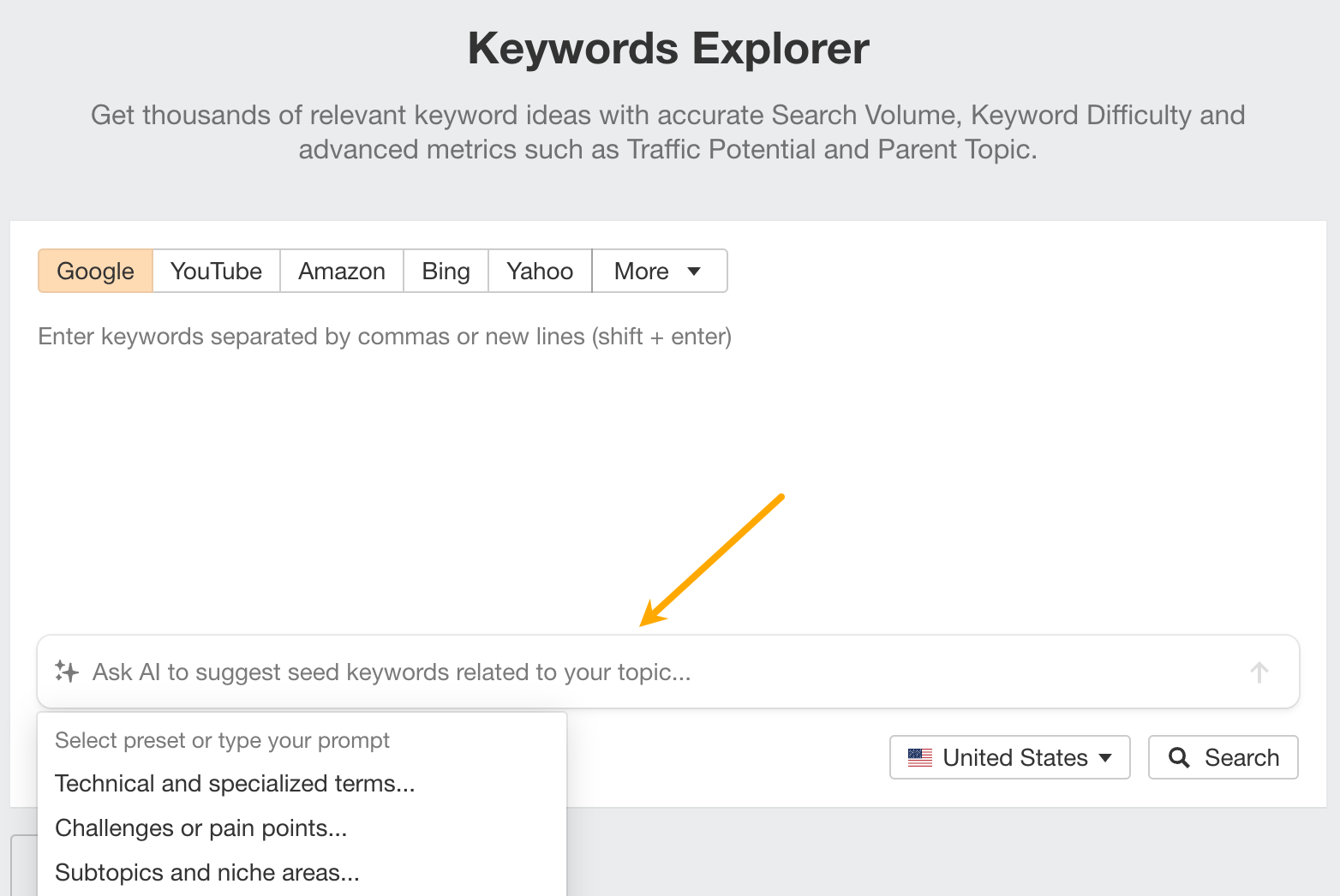

Next, make sure you’ve set up the country in which you’ll want to rank and hit “Search”.


After hitting the “Search” button, go to the Matching terms report. You will see a big list of keywords.
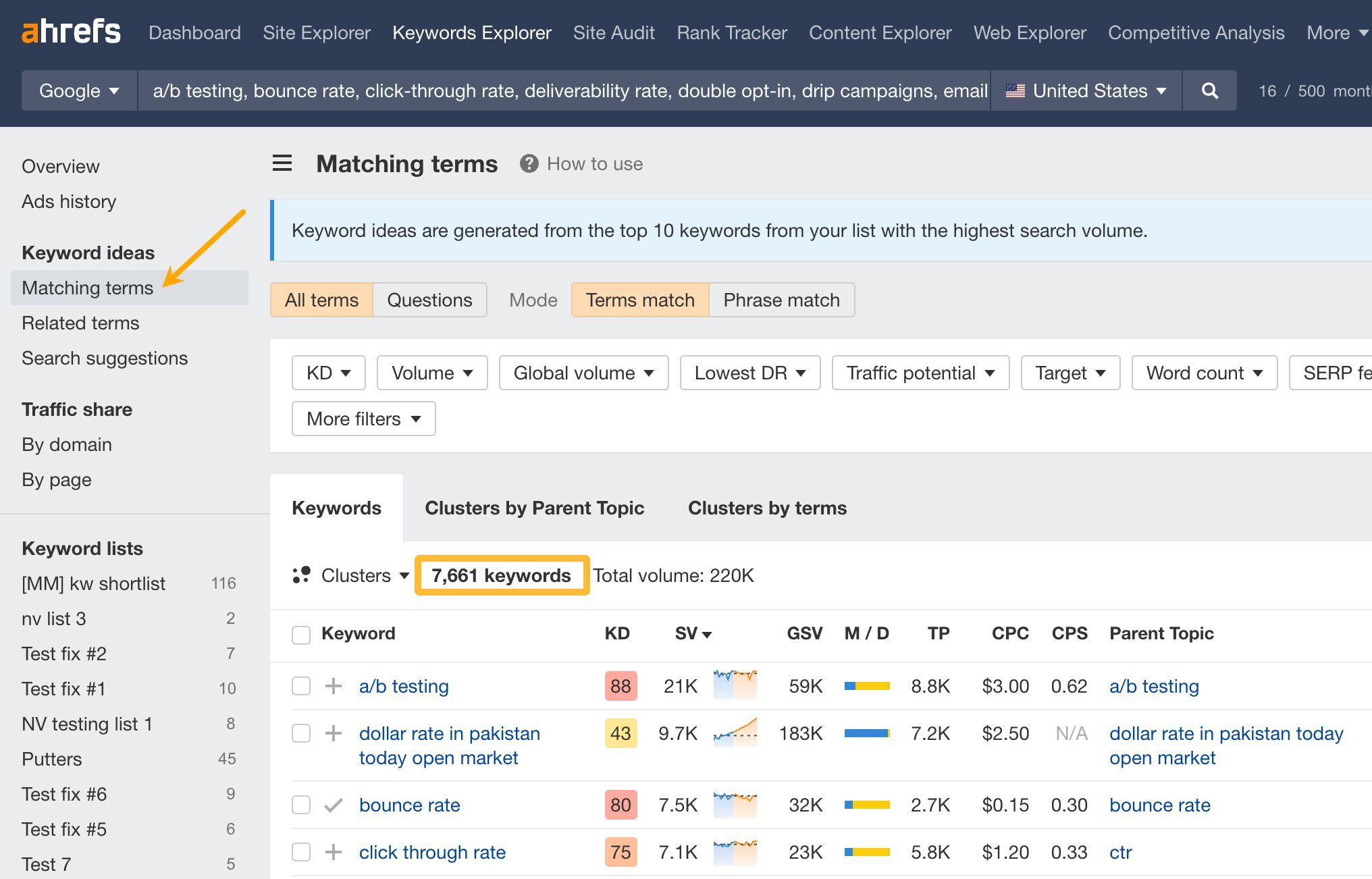

The list you’ll get will be quite raw — not all keywords will be equally good and the list will likely be too big to manage. Next steps are all about refining the list because we’ll be looking for target keywords — the keywords that will become the topic of your content.
2. Refine the list and cluster
The next step is to refine your list using filters.
Some useful basic filters are:
- KD (Keyword Difficulty): how difficult it would be to rank on the first page of Google for a given keyword.
- Traffic potential: traffic you can get for ranking #1 for that keyword and other relevant keywords (based on the page that currently ranks #1).
- Lowest DR (Domain Rating): plug in the DR of your site to see keywords where another site with the same DR already ranks in the top 10. In other words, it helps to find “rankable” keywords.
- Target: one of the main use cases is excluding keywords you already rank for.
- Include/Exclude: see keywords that contain specific words to increase relevancy/hide keywords with irrelevant words.
For example, here’s how to find potentially rankable keywords with traffic potential above 300 monthly visits. Go to the Matching terms report in Keywords Explorer and set filters: keyword difficulty filter (KD) to your site’s Domain Rating, Traffic potential, and Volume filters to a minimum of 300.
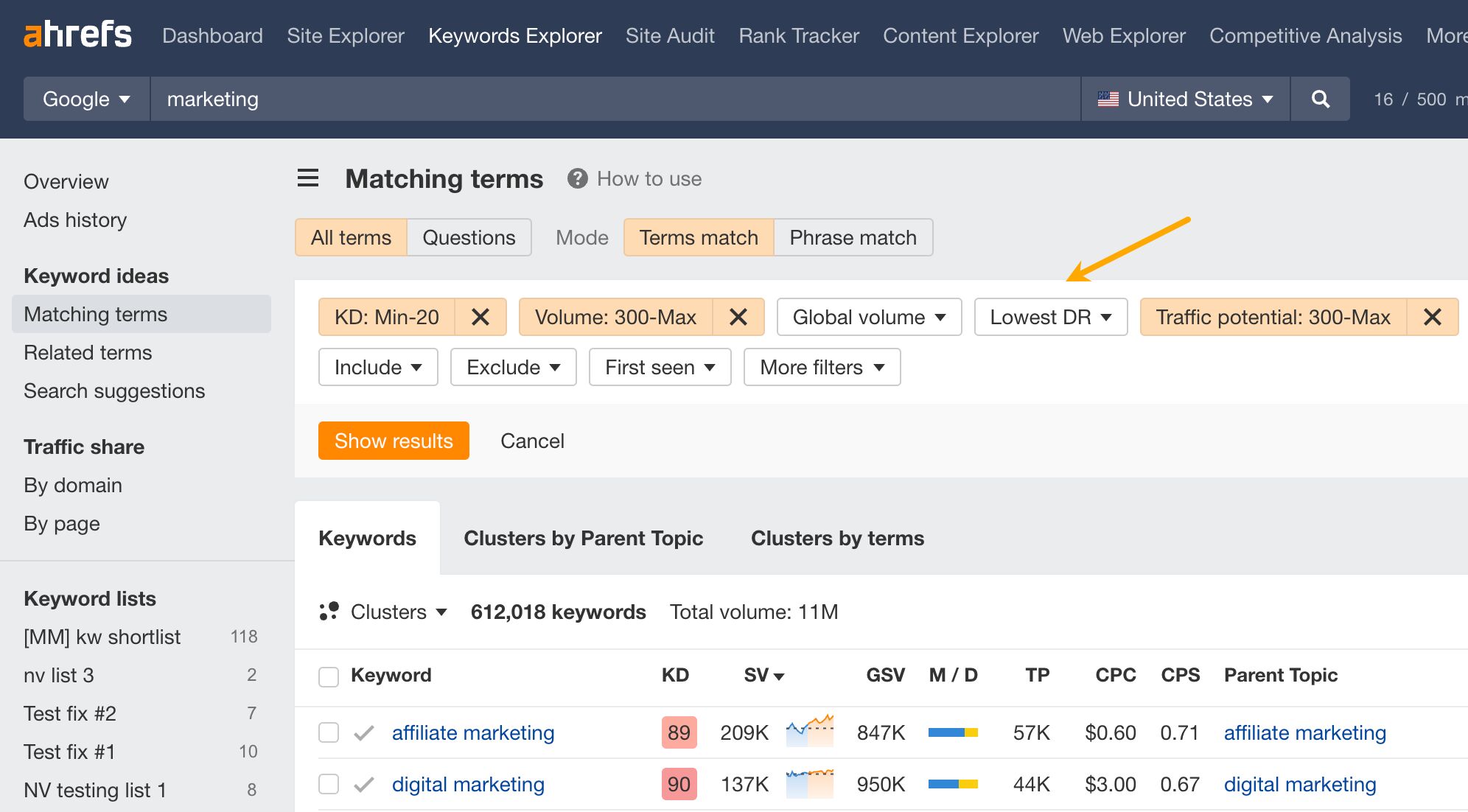

Clustering is another step to refine your list. It shows you if there is another keyword you could target to get more traffic (aka parent topic). At the same time, it shows which keywords most likely belong on the same page.
For example, here are some clusters distilled from low-competition topics about marketing.
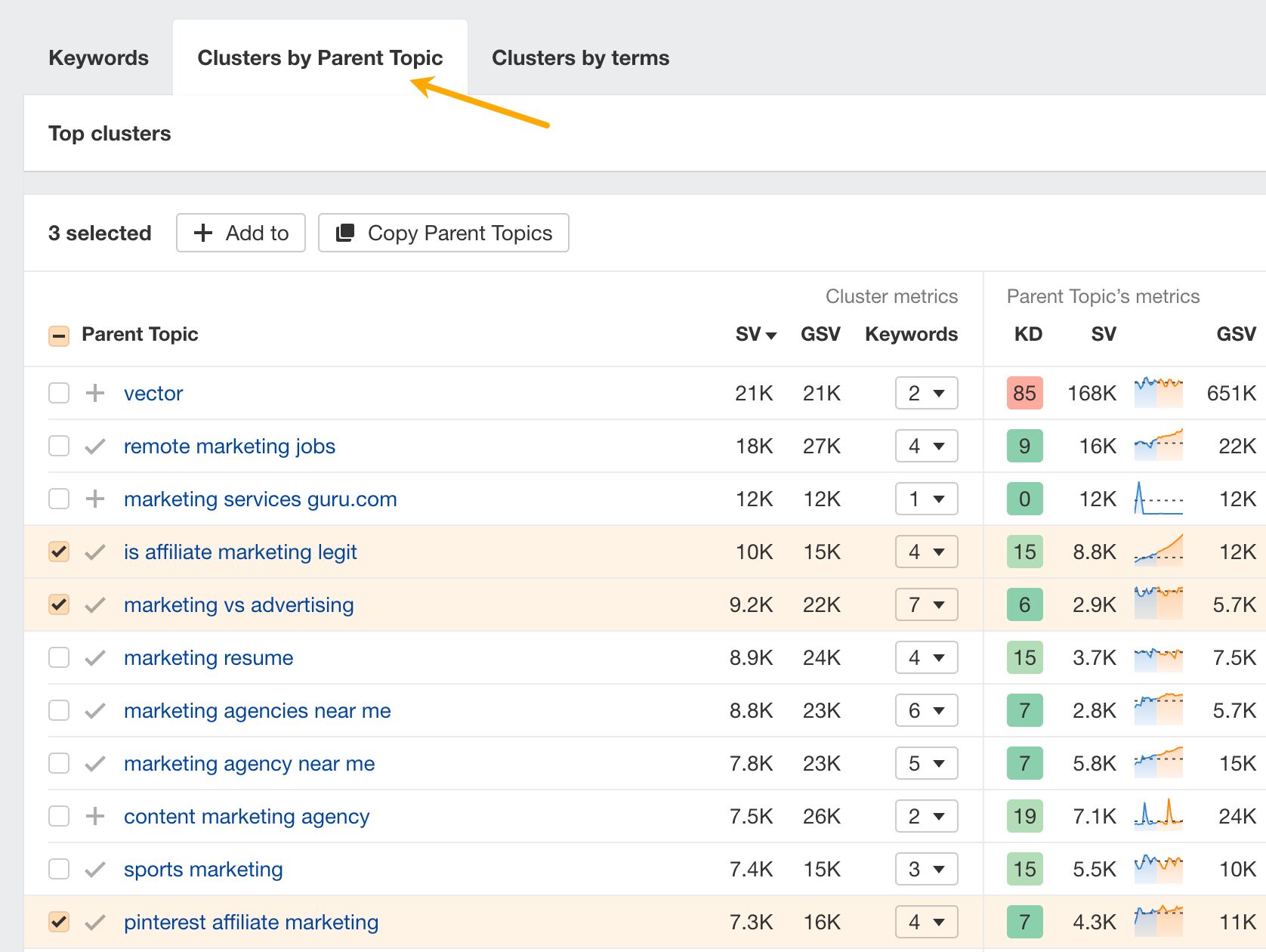

Pro tip
Take keyword trends into account when choosing keywords.
For example, the keyword “is affiliate marketing legit” is at 8.8k monthly search volume right now, but based on our forecast in Keywords Explorer (the orange part of the chart), if it continues its current growth rate it should be more than triple next year.
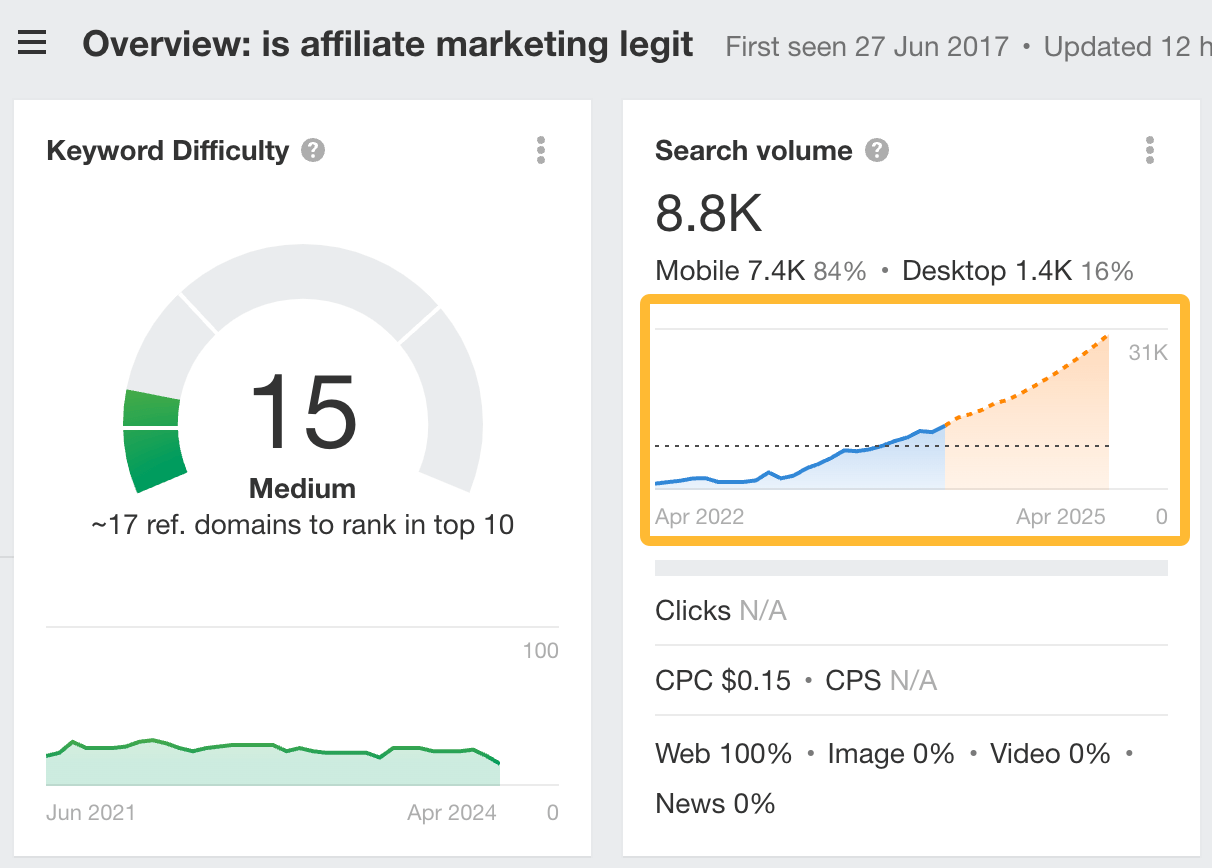

The graphs will also show you if the search volume is affected by seasonality (fluctuations in search volume throughout different times of the year).


4. Identify search intent and determine value for your site
Before investing time in content, make sure you can give searchers what they want and that the keywords will attract the right kind of audience.
To identify the type of page you need to create to satisfy searchers, look at the top-ranking pages to see what purpose they serve (are they more informational or commercial), or simply use the Identify intents AI feature in Keywords Explorer.
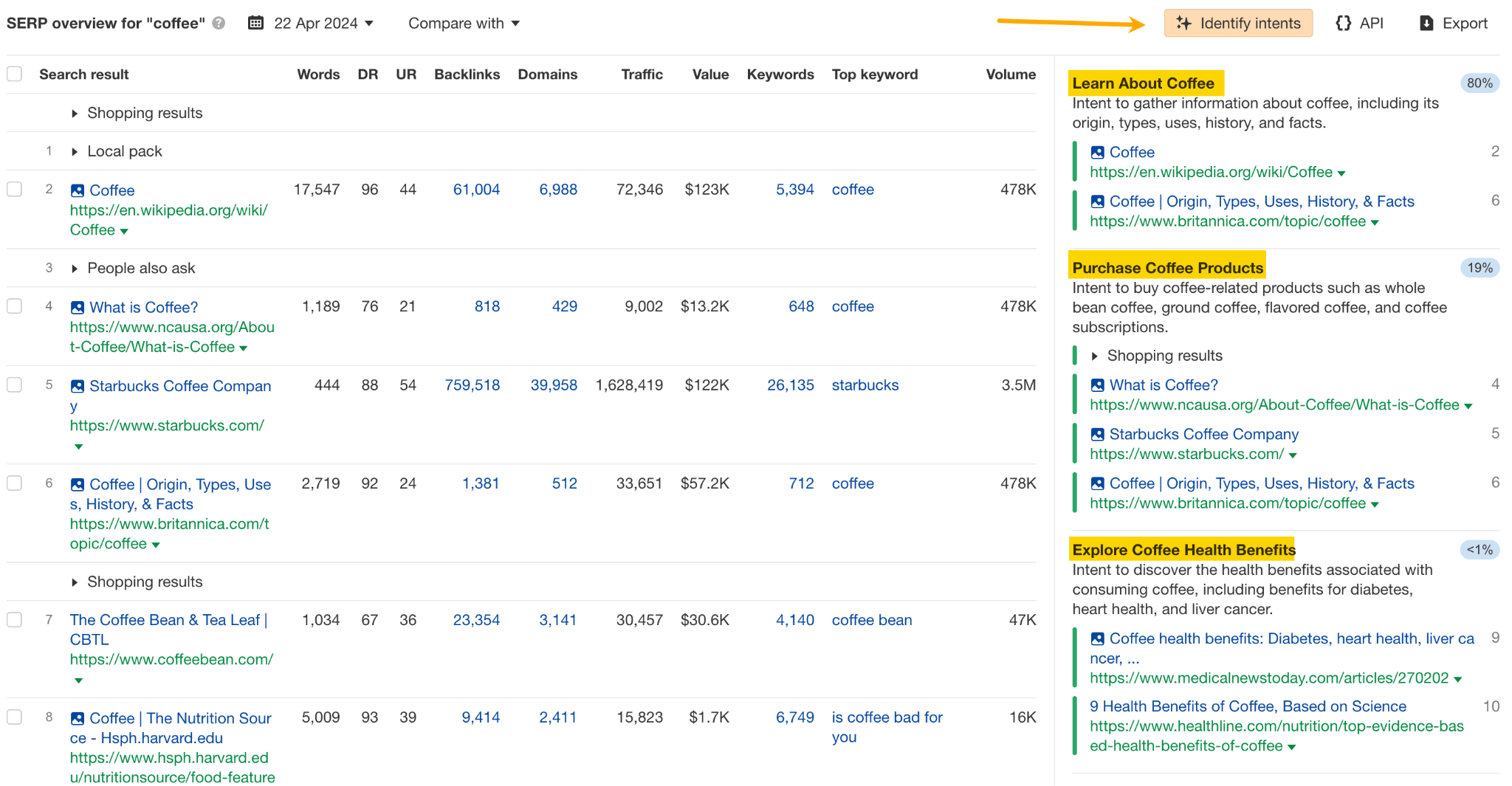

So, for example, if the top-ranking pages are ecommerce pages and you’re not offering products on your site, it’s going to be very hard to rank.
Then, ask yourself if visitors attracted by a keyword will be valuable to your business — whether they’re likely to subscribe to your newsletter or make a purchase. At Ahrefs, we use a business potential score to evaluate this.
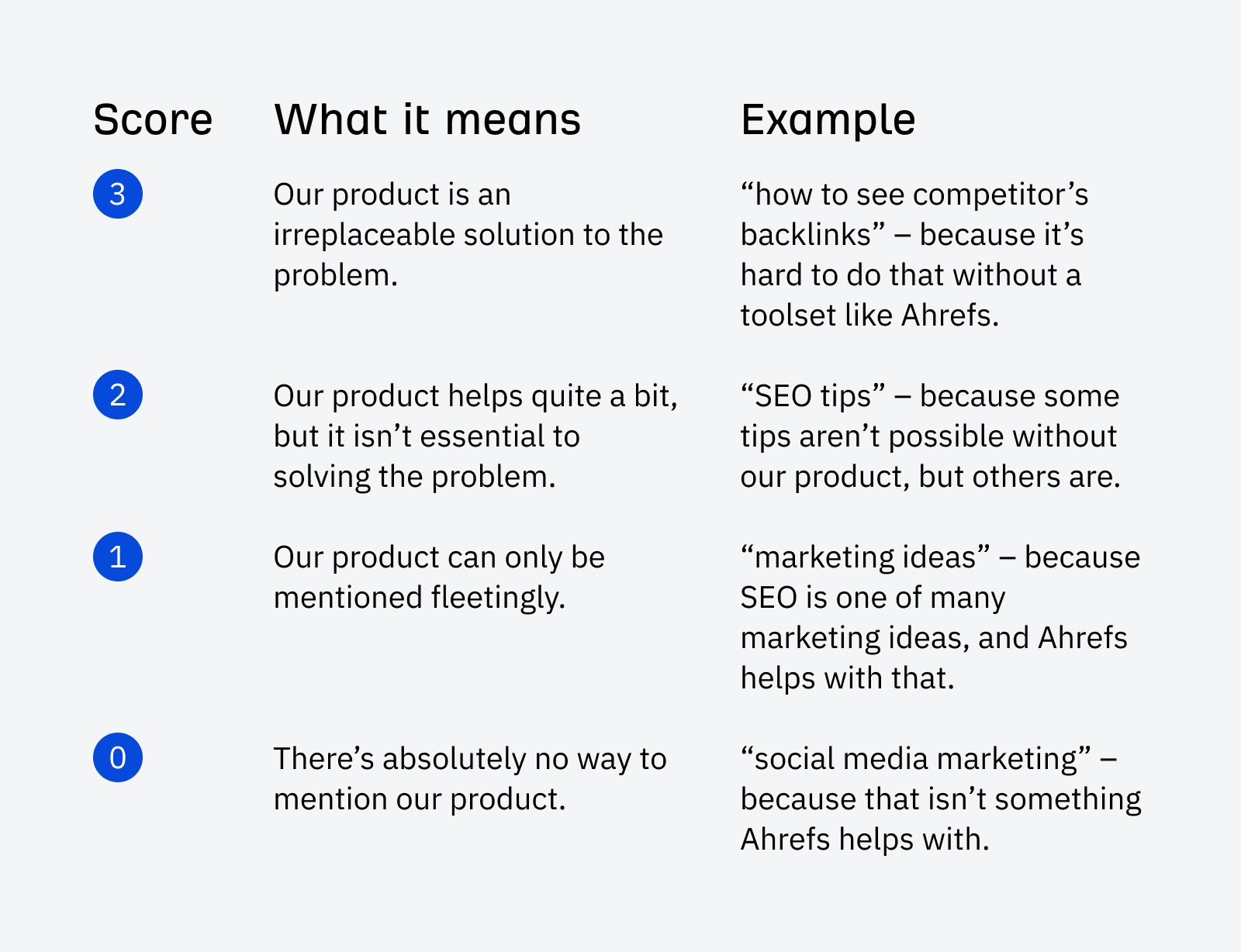

Finally, if a keyword checks all boxes, add it to a keyword list.
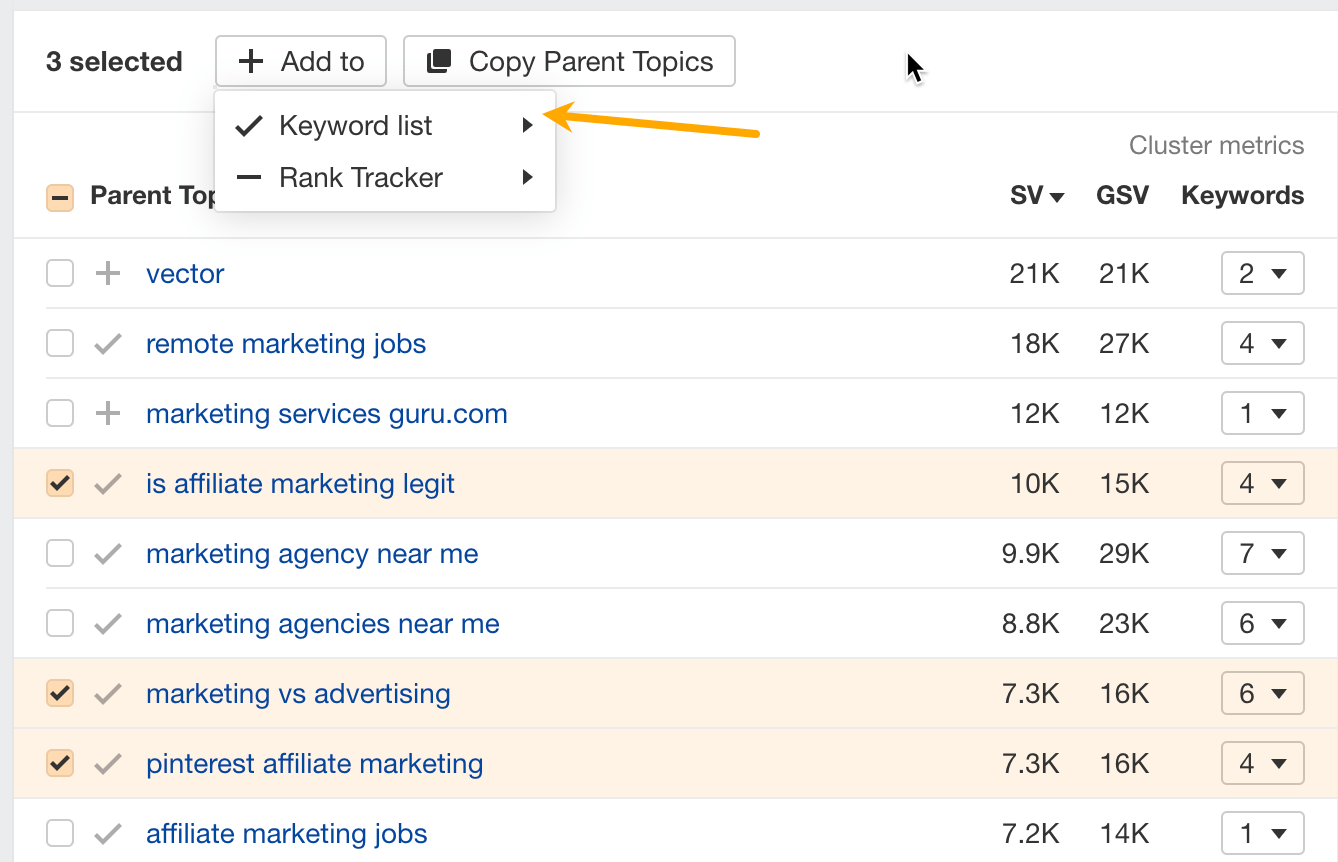

Now you’ve got a list of relevant, valuable target keywords with traffic potential ready for content creation. You can repeat the process as many times as you like with different seed keywords or different filters and find new ideas.
There’s one more great source of keywords — competitors.
5. Enrich the list with your competitors’ keywords
In this step, we’ll do a content gap analysis to find keywords your competitors already rank for, but you don’t.
First, let’s find your competitors.
- Enter your domain in Ahrefs’ Site Explorer and go to the Organic competitors report.
- Select the most relevant competitors and click on Copy (this copies URLs — we’ll use them in another tool).
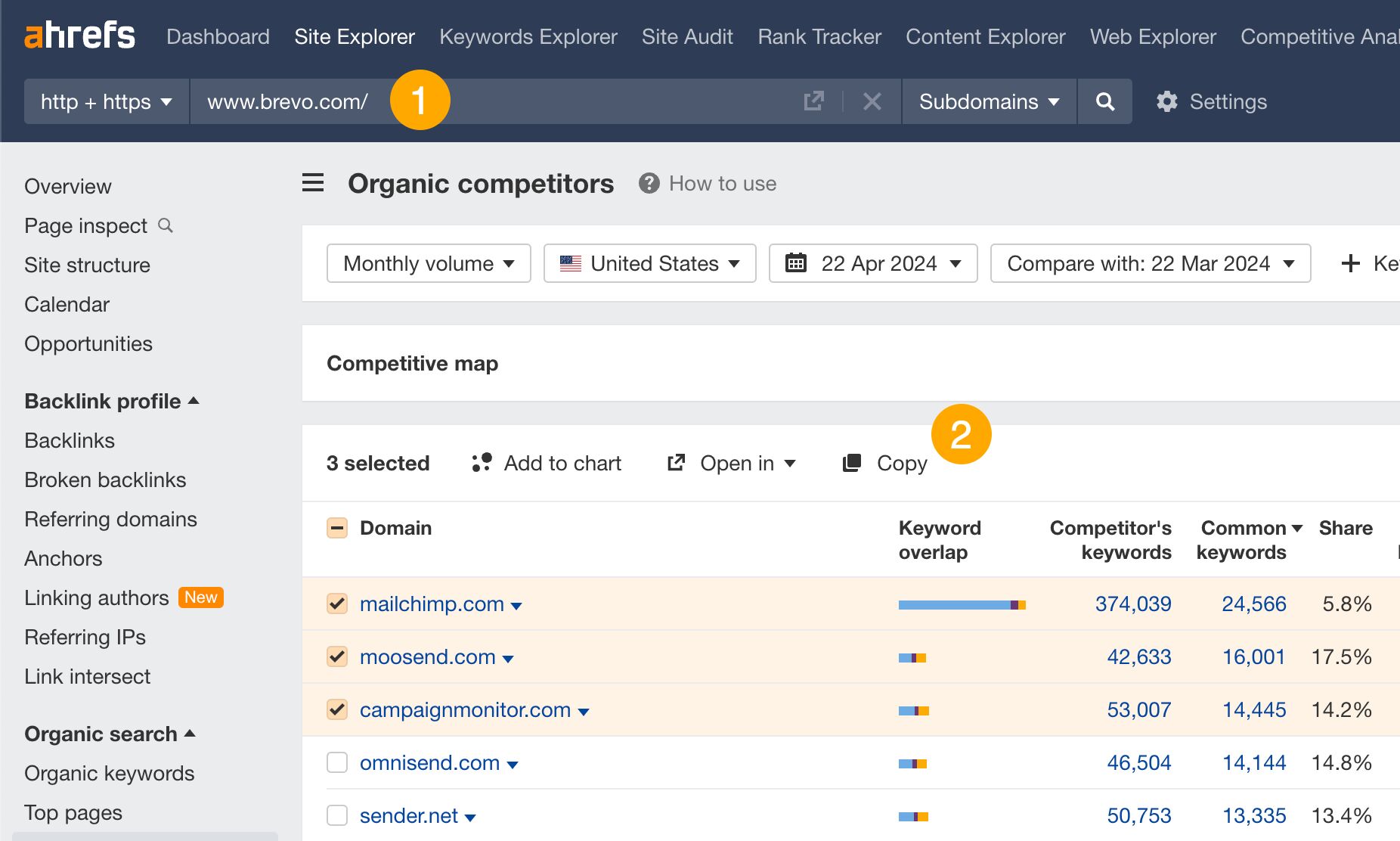

Next, we’ll see which keywords you’re missing.
- Go to Ahrefs’ Competitive Analysis tool, paste the previously copied URLs, enter your domain on top and hit Show keyword opportunities.


- In the Content gap report, use filters to refine the report.
- Select keywords and add them to your list.


Pro tip
If you stumble across two similar keywords there’s an easy way to determine if they belong on the same page.
- Enter the keyword in Keywords Explorer.
- Scroll to SERP overview, click Compare with, and enter the keyword to compare with.
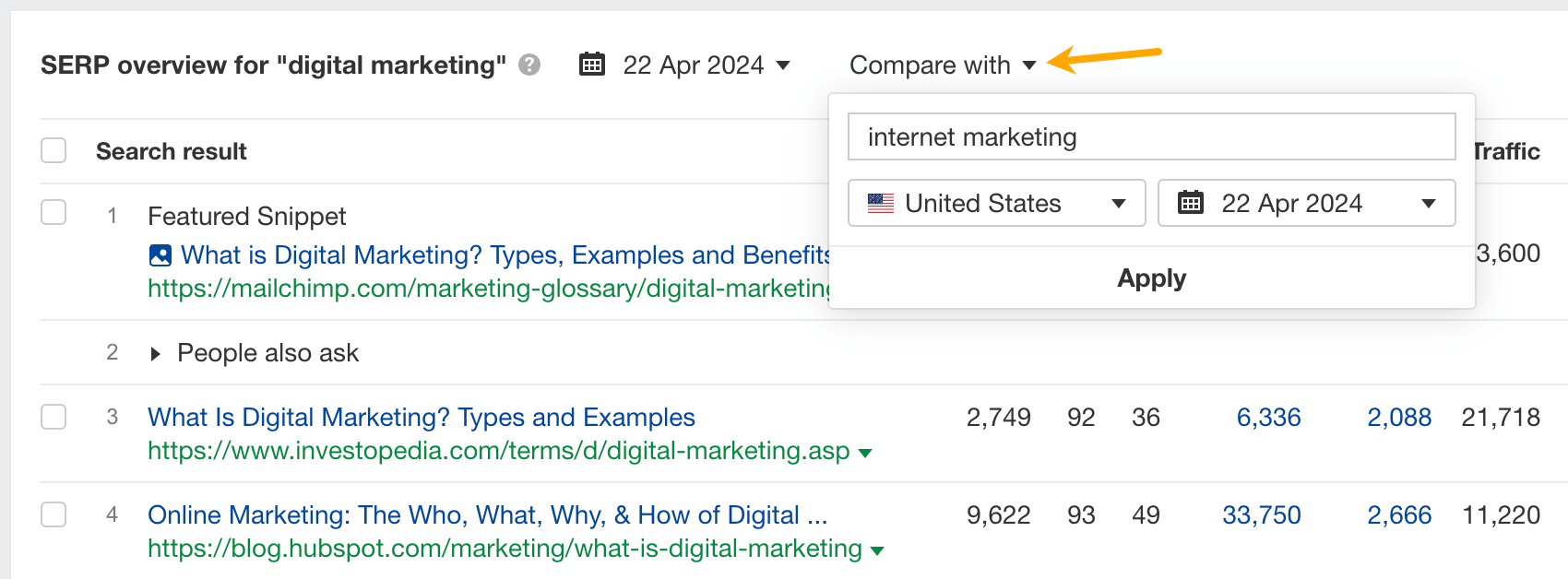

- Fewer common results and low SERP (Search Engine Result Page) similarity mean separate pages should target the two keywords.


Once you have your target keyword, you can include it in relevant places in your on-page content, including:
- Key elements of search intent (content type, format, and angle).
- URL slug.
- Title and H1.
- Meta description.
- Subheadings (H2 – H6).
- Main content.
- Anchor text for links.
And, just so we’re on the same page, the target keyword is the topic of the content and the main keyword you’ll be optimizing for and tracking later on.
Use the target keyword to determine the search intent
Search intent is the reason behind the search. Understanding it tells you what users are looking for and what you need to deliver in your content.
To identify search intent, look at the top-ranking results for your target keyword on Google and identify the three Cs of search intent:
- Content type – What is the dominating type of content? Is it a blog post, product page, video, or something else? If you’ve done that during the keyword research phase (highly recommended), only two elements to go.
- Content format – Some common formats include how-to guides, list posts, reviews, comparisons, etc.
- Content angle – The unique selling point of the top-ranking points, e.g., “best,” “cheapest,” “for beginners,” etc. Provides insight into what searchers value in a particular search.
For example, most top-ranking pages for “avocado seed” are blog posts serving as how-to guides for planting the seed. The use of easy and simple angles indicates that searchers are beginners looking for straightforward advice.
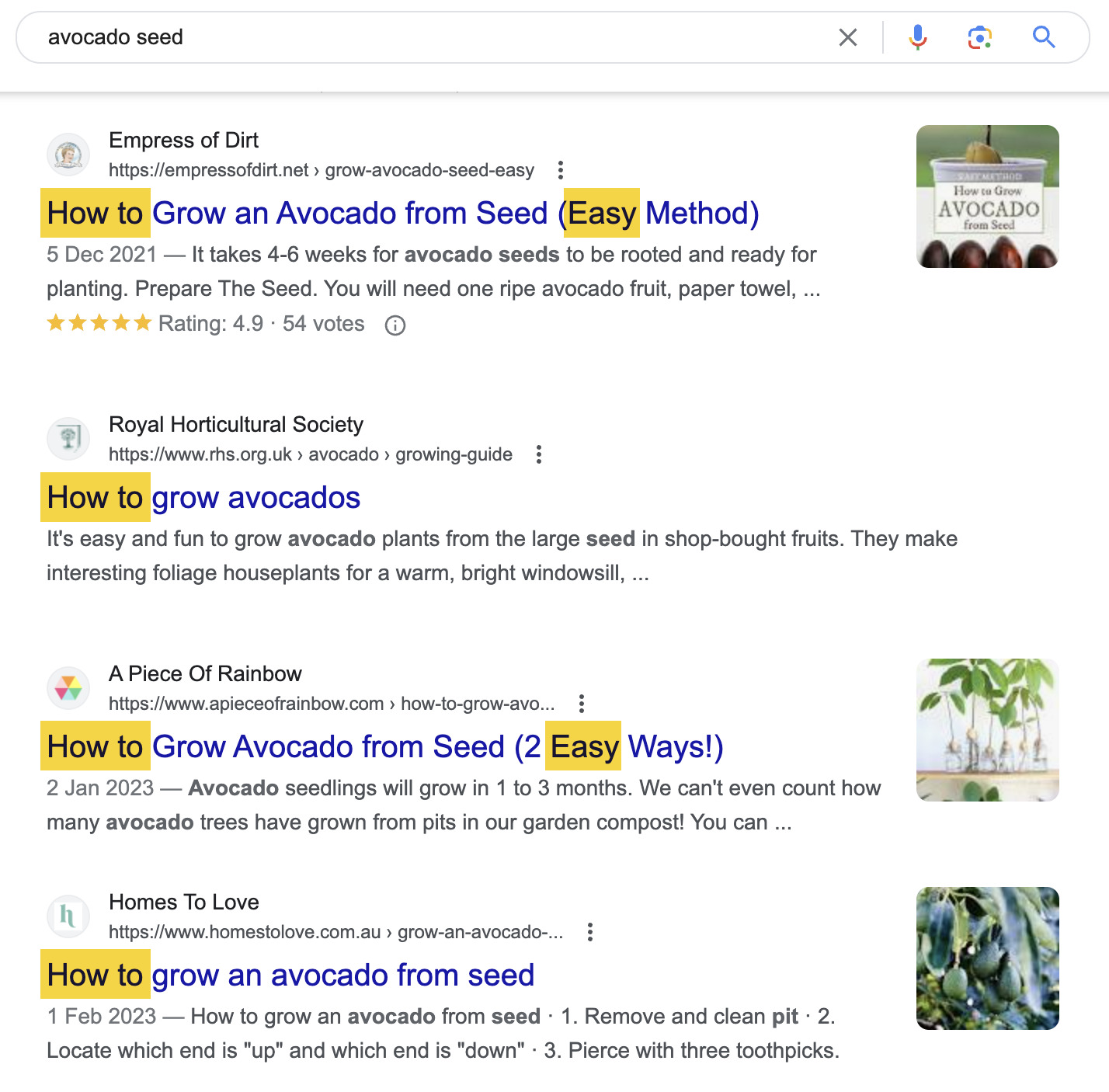

Use the target keyword in the URL slug
A URL slug is the part of the URL that identifies a specific page on a website in a form readable by both users and search engines.
If you look at the URL of the page you’re on, that will be the last part, “how-to-use-keywords-seo”.
https://ahrefs.com/blog/how-to-use-keywords-seoGoogle says to use words that are relevant to your content inside page URLs (source). Usually, the easiest way to do that is to set your target keyword in the slug part of the URL.


Use the target keyword in the title and match it with the H1 tag
A title tag is a bit of HTML code used to specify the title of a webpage.
<title>How to Use Keywords for SEO: A-Z Guide For Beginners</title>The H1 tag is an HTML heading that’s most commonly used to mark up a web page title.
<h1>How to Use Keywords for SEO: A-Z Guide For Beginners</h1>Both are very important to Google and searchers. Since they both indicate what the page is about, you can just match them, like I did in this article.
Titles help Google understand the context of a page. What’s more, even a slight improvement to your title can improve your rankings.


Google advises focusing on creating good titles, which should be “unique to the page, clear and concise, and accurately describe the contents of the page” (source). It’s hard to think of a better way to accurately describe the contents other than using the target keyword.
If it makes sense for the title, aim for an exact match of the keyword. But if you need to insert a preposition or break the phrase, this won’t make Google think your page is less relevant. Google understands close variations of the keyword really well, so there’s no need to stuff in similar keywords, misspellings, etc.
To illustrate, my old article on how to see keywords that Google Analytics won’t show ranks #1 for many variations of the phrase in the title.


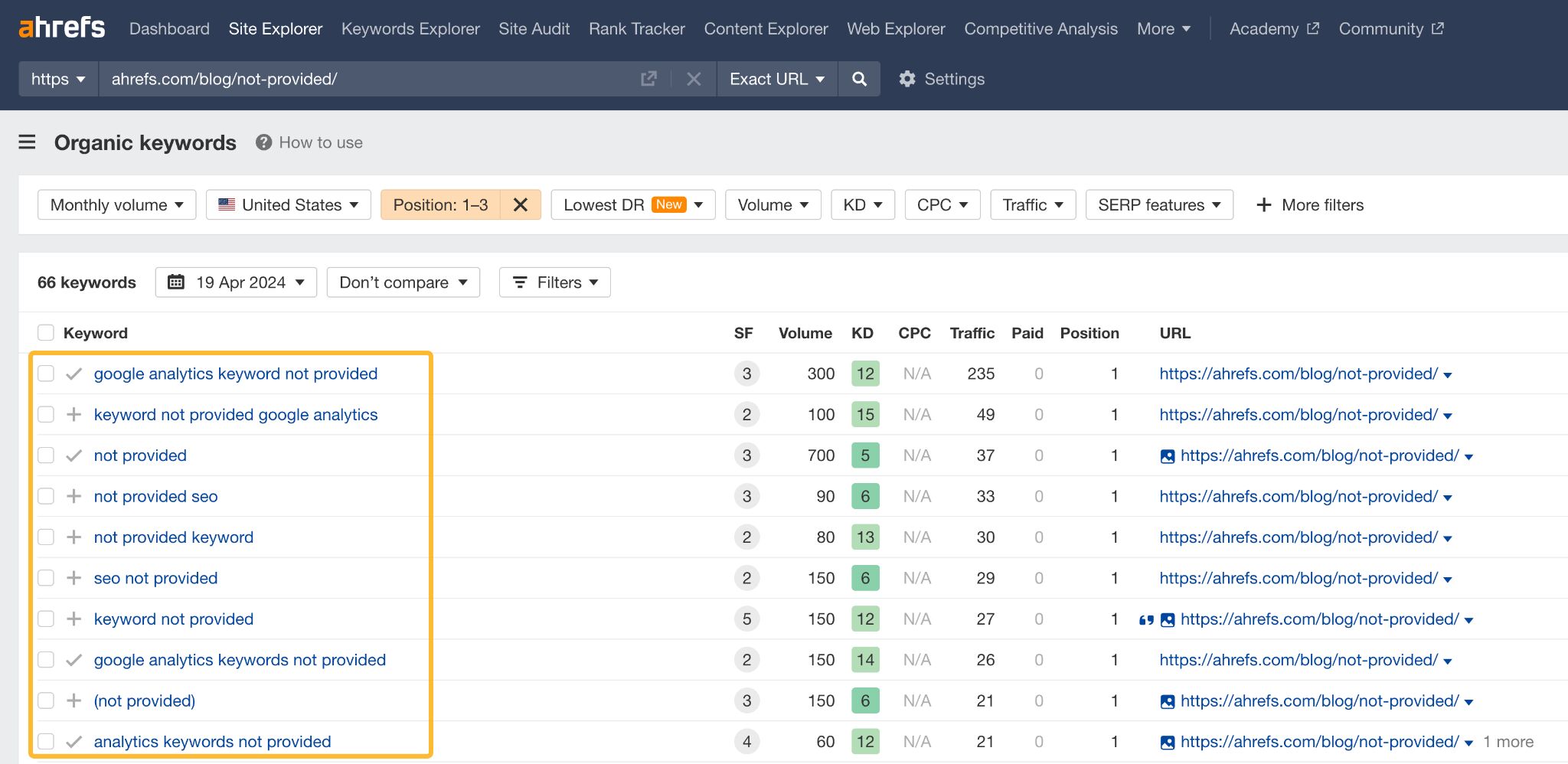

Use the keyword in meta description
However, don’t write meta descriptions solely for Google; Google rewrites them more than half of the time (study) and doesn’t use them for ranking purposes. Instead, focus on crafting meta descriptions for searchers.
These descriptions appear in the SERPs, where users can read them. If your description is relevant and compelling, it can increase the likelihood of users clicking on your link.
Including your target keyword in the meta description is usually natural. For instance, consider the description of the article mentioned earlier. Incorporating the keyword into the sentences simply provides a comprehensive way to describe the issue.
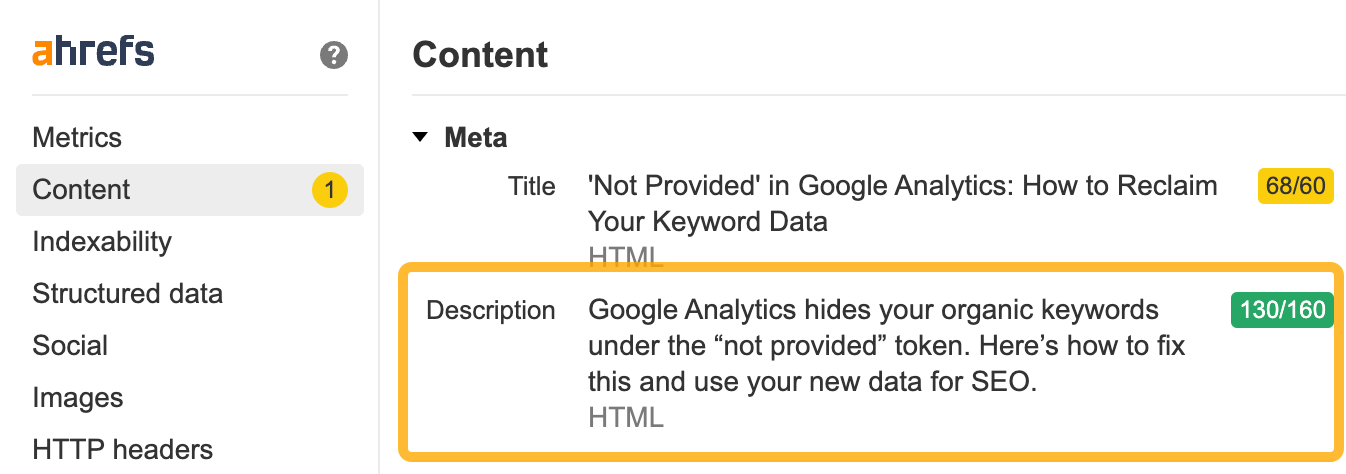

Use the target keyword to find secondary keywords
Secondary keywords are any keywords closely related to the primary keyword that you’re targeting with your page.
You can find them through your primary keyword and use them as subheadings (H2 to H6 tags) and talking points throughout the content. Here’s how.
Go to Keywords Explorer and plug in your target keyword. From there, head on to the Related terms report and toggle between:
- Also rank for: keywords that the top 10 ranking pages also rank for.
- Also talk about: keywords frequently mention by top-ranking articles.


Now, to know how to use these keywords in your text, just manually look at the top ranking pages and see how and where they cover the keywords.
For example, looking at one of the top articles for “digital marketing”, we can see right away that some of the most important aspects are the definition, a template and importance. You can use the free Ahrefs SEO Toolbar to break down the structure of any page instantly.


Another place you can look for inspiration is the People Also Ask Box in the SERPs. Use it to find words and subtopics that may be worth adding to the article.
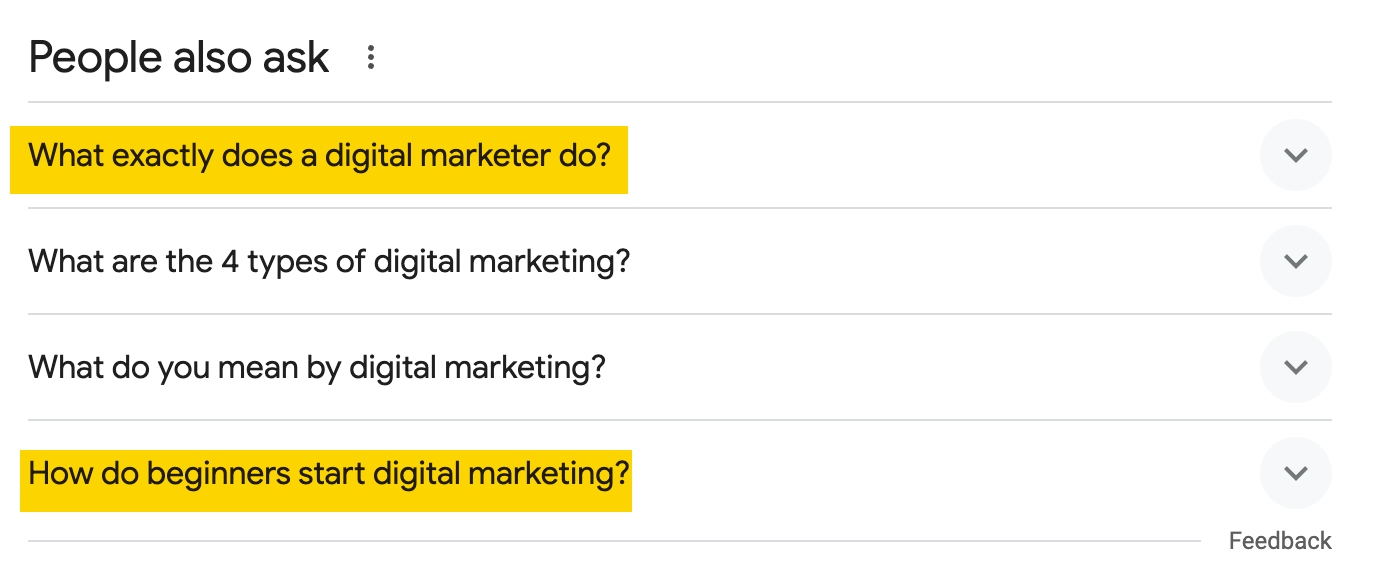

Pro tip
Optimizing an existing article?
Use the Content Gap tool to find subtopics you may be missing. The tool shows keywords that your competitors’ pages rank for, and your page doesn’t.
- Go to Keywords Explorer and enter your target keyword.
- Scroll down to the SERP overview, select a few top pages, and click Open in Content Gap.
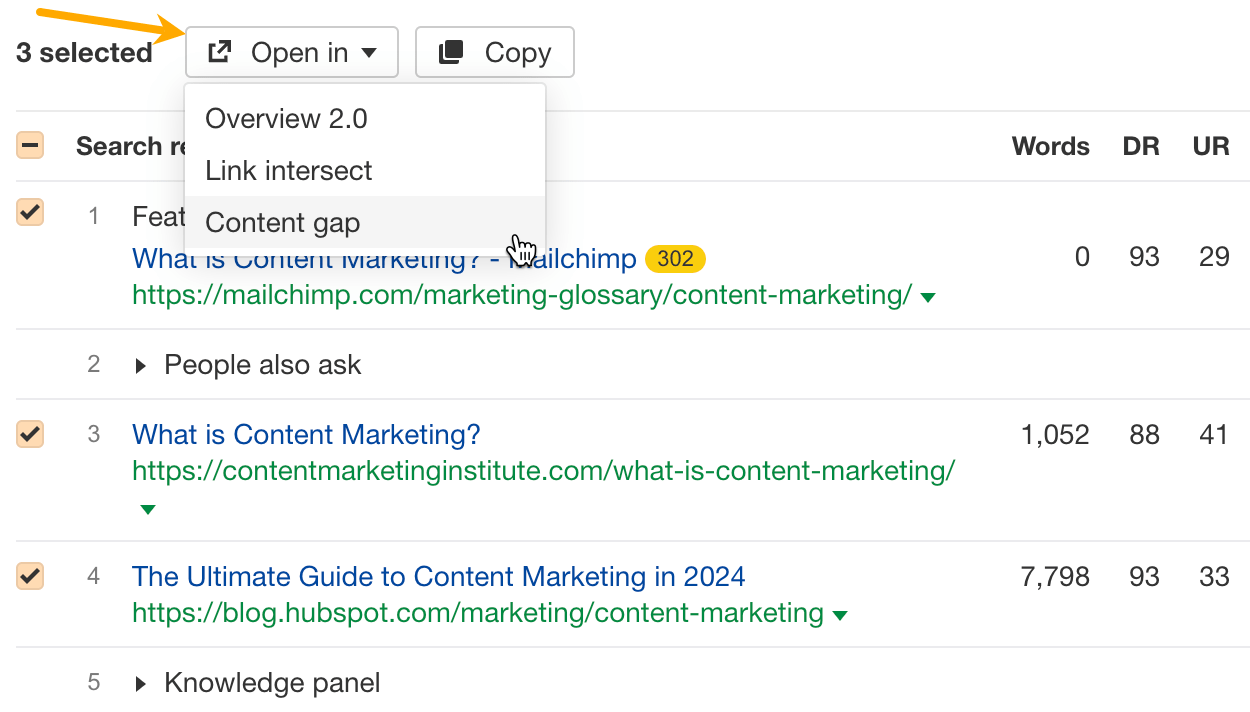

- In Content Gap, click on Targets and add the page you’re optimizing in the last field.
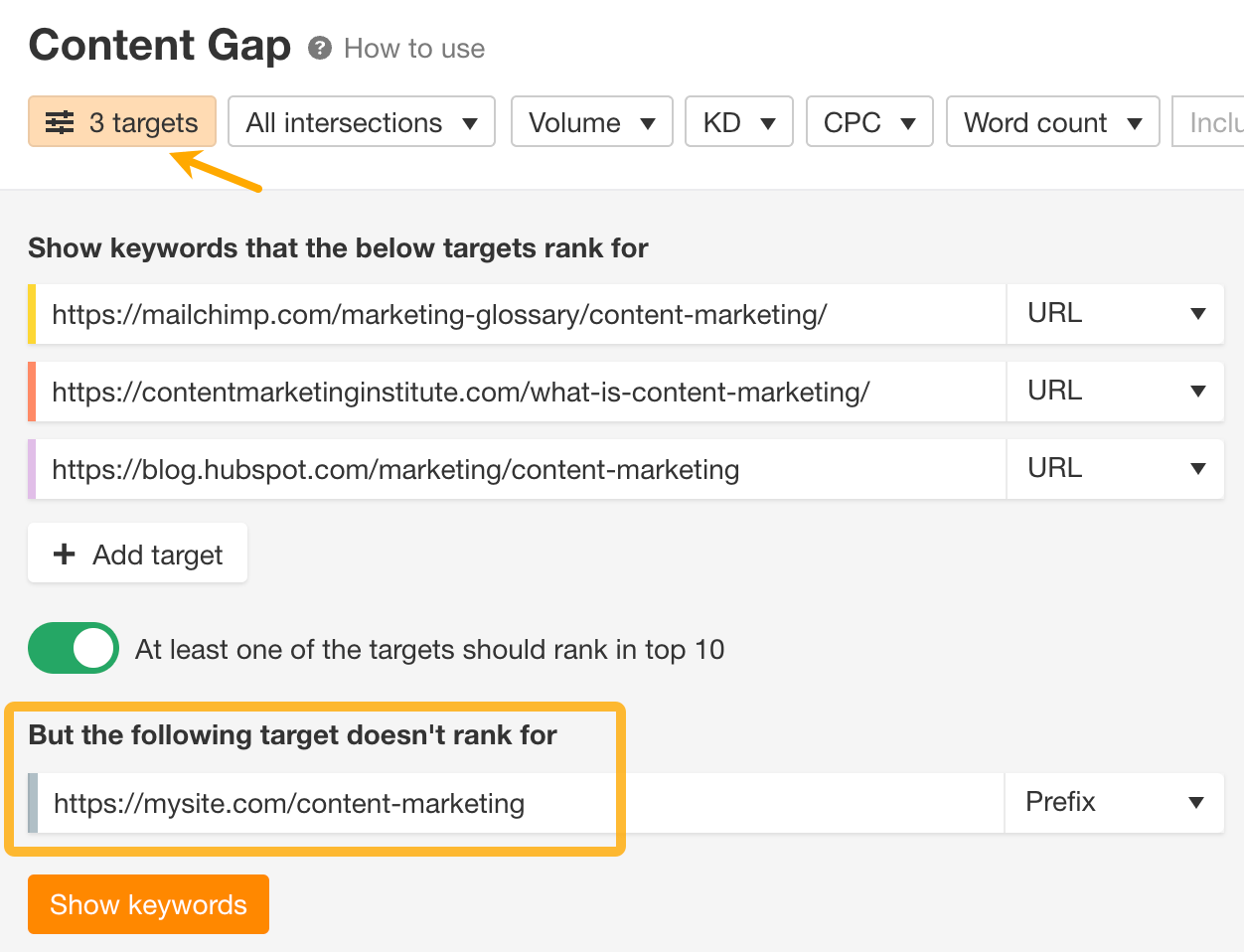

Use primary and secondary keywords in the main content
To rank high on search engines, it’s important to include your keywords in your text. Even though Google is good at understanding similar words and variations, it still helps to use the specific keywords people might search for. Google explains that in their short guide to how search works:
The most basic signal that information is relevant is when content contains the same keywords as your search query. For example, with webpages, if those keywords appear on the page, or if they appear in the headings or body of the text, the information might be more relevant.
When writing, it’s important to incorporate keywords naturally. Start your content with the most relevant information that people are likely to search for. This ensures that key points are immediately visible to your readers and search engines.


If you have a secondary keyword that’s less critical but still relevant, consider giving it a dedicated section. This approach allows you to explore the topic in detail, rather than briefly mentioning it at the end of your content.


However, avoid overemphasizing the frequency of your keywords. Effective SEO involves more than just repeating keywords. If SEO were simply about keyword density, it would be straightforward, but such strategies don’t lead to long-term success and can make your content feel spammy.
For instance, if ‘content strategy’ is a central theme of your discussion and you mention it only once, Google might perceive your content as incomplete. On the other hand, stuffing your article with the term ‘content strategy’ more than necessary won’t outperform your competitors and could potentially lead to your site being flagged as spam.
Use the target keyword in link anchor text and/or surrounding text
The anchor text or link text is the clickable text of an HTML hyperlink.
Google uses anchors to understand the page’s context. There even seems to be a consensus that anchor text is a ranking factor, although, according to our study, it is likely a weak one.
In situations like these, it’s just best to stick with Google’s advice:
Good anchor text is descriptive, reasonably concise, and relevant to the page that it’s on and to the page it links to. It provides context for the link, and sets the expectation for your readers. (…)
Remember to give context to your links: the words before and after links matter, so pay attention to the sentence as a whole.
So use the target keyword in the anchor text and or surrounding text but keep it natural — add only on pages that are related to the page you’re linking to and use text that will help the readers understand where and why you’re linking.


Rank tracking refers to monitoring the positions of a website’s pages in search engine results for specific keywords.
It’s pretty much an automated process; everything can be handled by a tool like Ahrefs’ Rank Tracker. No need to check rankings manually and note them down in a spreadsheet.
If you have a keyword list ready, all you need to do is add that list to Rank Tracker.


The keywords will appear in Rank Tracker’s Overview report.
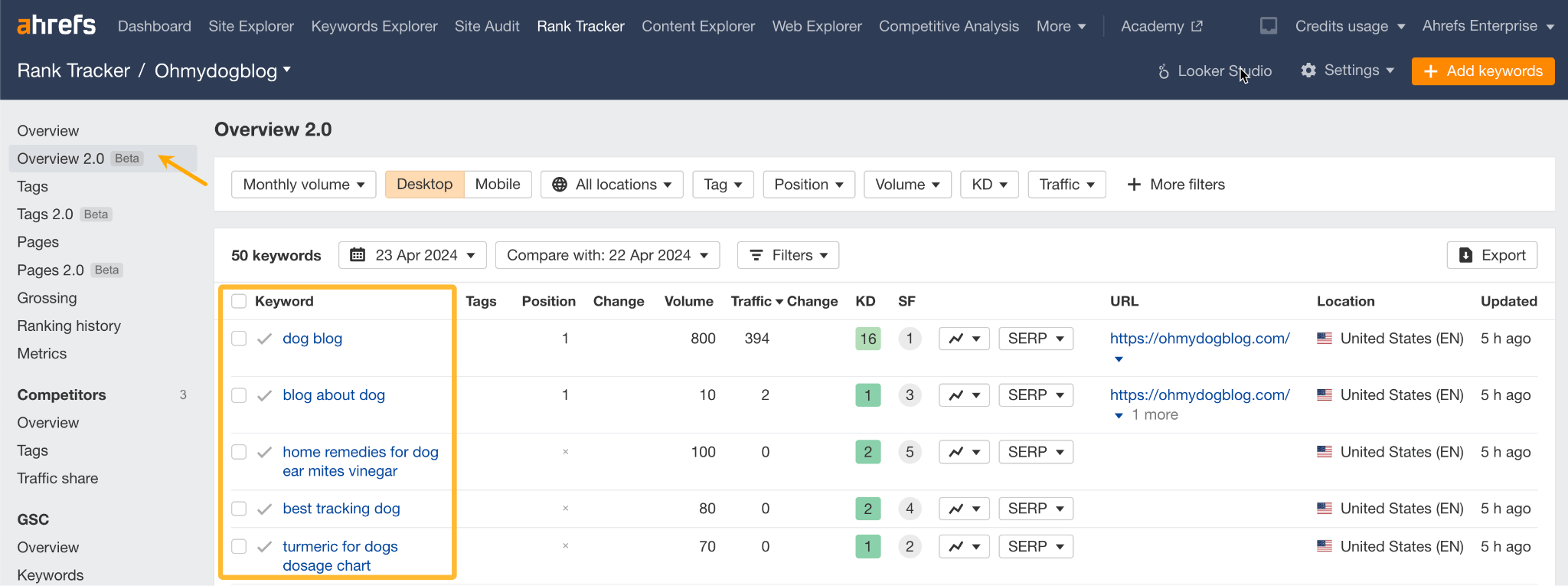

Another way to add keywords is to hit Add keywords in the top right corner (best for adding single keywords or importing a list from a document).


Now to compare your performance against competitors, just go to the Competitors report. The metric I recommend tracking is SOV (Share of Voice). It shows how many clicks go to your pages compared to competitors.
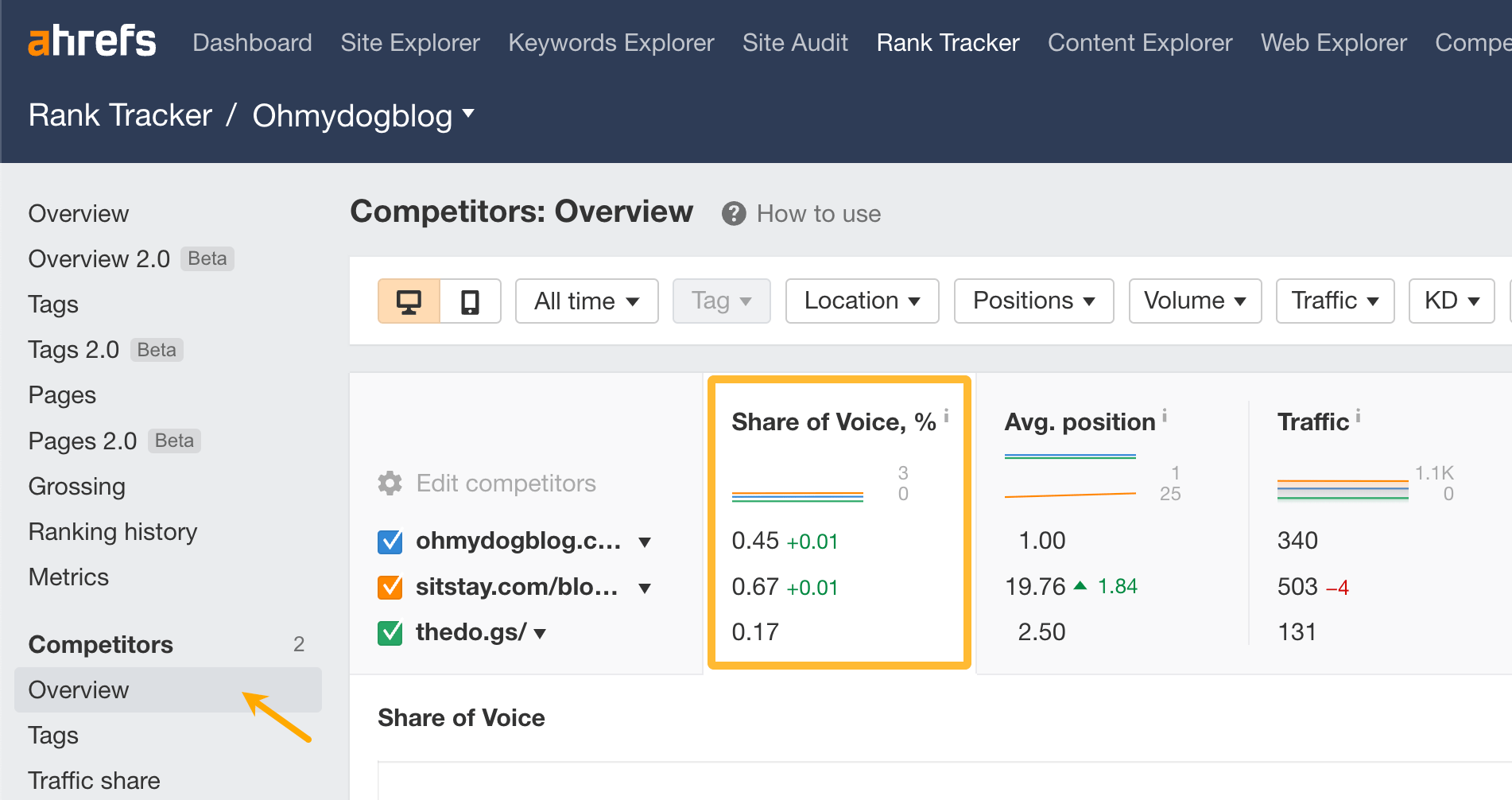

One of the key advantages of SOV is that it accounts for fluctuations in search volume trends. Therefore, if you notice a decrease in traffic but maintain a high SOV, it indicates that the drop is due to a decrease in the overall popularity of the keywords, not a decline in your SEO effectiveness.
But not only can you track your competitors’ keywords, you can also monitor them. Use a tool like Ahrefs Alerts to get notifications whenever your competitors started working for a new keyword.
Just to go Alerts tool in Ahrefs and fill in the details.


There’s even more you can do with keywords and a bit more you should know to avoid some common mistakes.
1. Use keywords to find guest blogging opportunities
Guest blogging is the practice of writing and publishing a blog post on another person or company’s website.
It’s one of the most popular link building tactics with a few other benefits like exposure to a new, targeted audience.
Here’s how to find relevant, high-quality sites to pitch:
- Go to Ahrefs’ Content Explorer.
- Enter a broad keyword or phrase related to your niche.
- Select In title from the drop-down menu.
- Run the search.


Next, refine the list by applying these filters:
- Domain Rating (DR) from 30 to 60.
- Click the One page per domain filter.
- Click the Exclude homepages filter.
- Click the Exclude subdomains filter.


Finally, click on the Websites tab to see potential websites you could guest blog for.
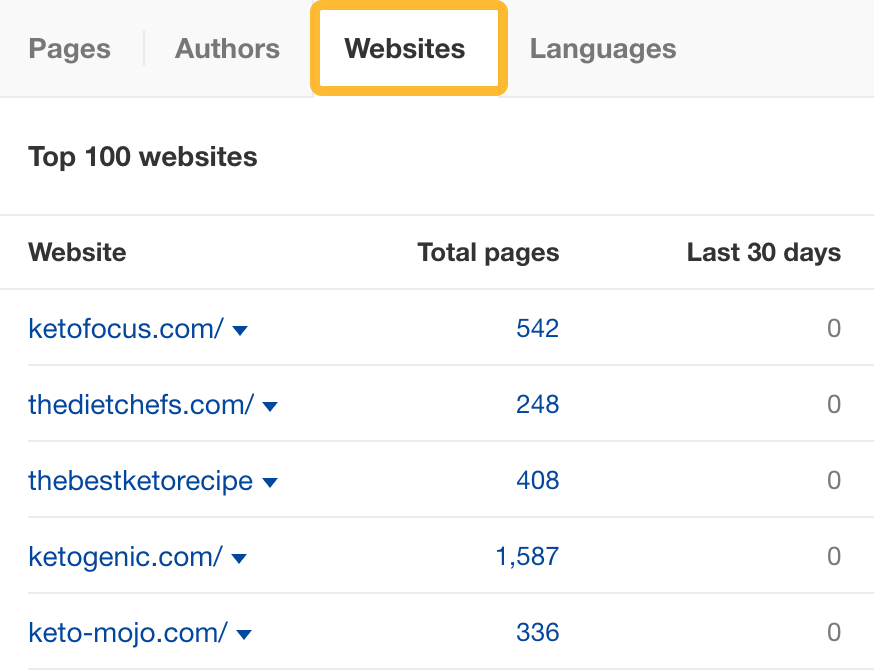

2. Use keywords to find internal link opportunities
Internal links take visitors from one page to another on your website. Their main purpose is to help visitors easily navigate your website, but they can also help boost SEO by aiding the flow of link equity.
Finding new internal link opportunities is also a time-consuming process if done manually, but you can identify them in bulk using Ahrefs’ Site Audit. The tool takes the top 10 keywords (by traffic) for each crawled page, then looks for mentions of those on your other crawled pages.
Click on the Internal link opportunities report in Site Audit.
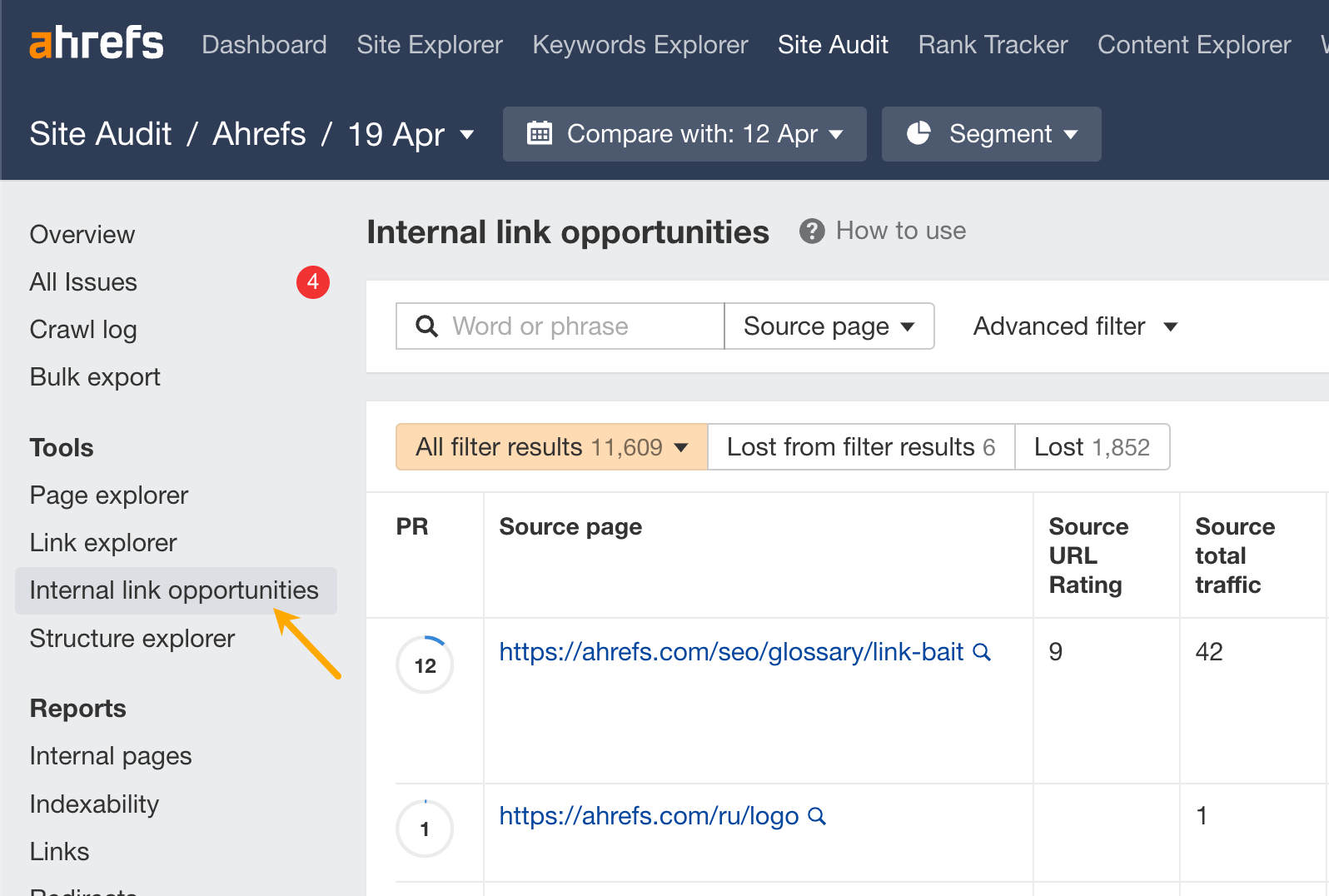

You’ll see a bunch of suggestions on how to improve your internal linking using new links. The tool even suggests exactly where to place the internal link.


3. Use keywords to find link building opportunities
Link building is the process of getting other websites to link to pages on your website. Its purpose is to boost the “authority” of your pages in the eyes of Google and help your pages rank.
A good place to start is to pull up the top-ranking pages for your target keyword and research where they got their links from.
Put your keyword into Keywords Explorer and scroll down to the SERP overview. You’ll see the top-ranking pages and their number of backlinks (and linking domains).
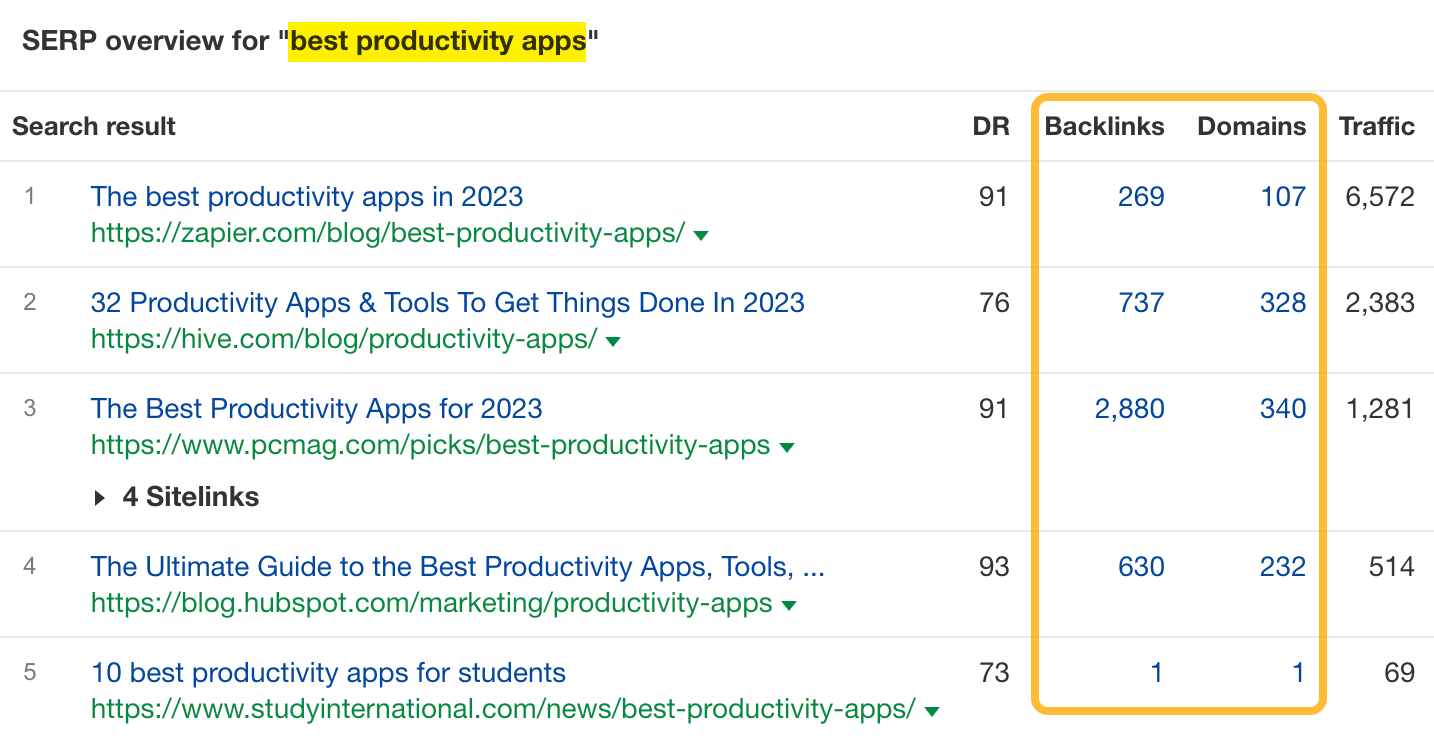

Once you click on any of the backlink numbers, you’ll be redirected to a list of backlinks of a given page in Site Explorer.
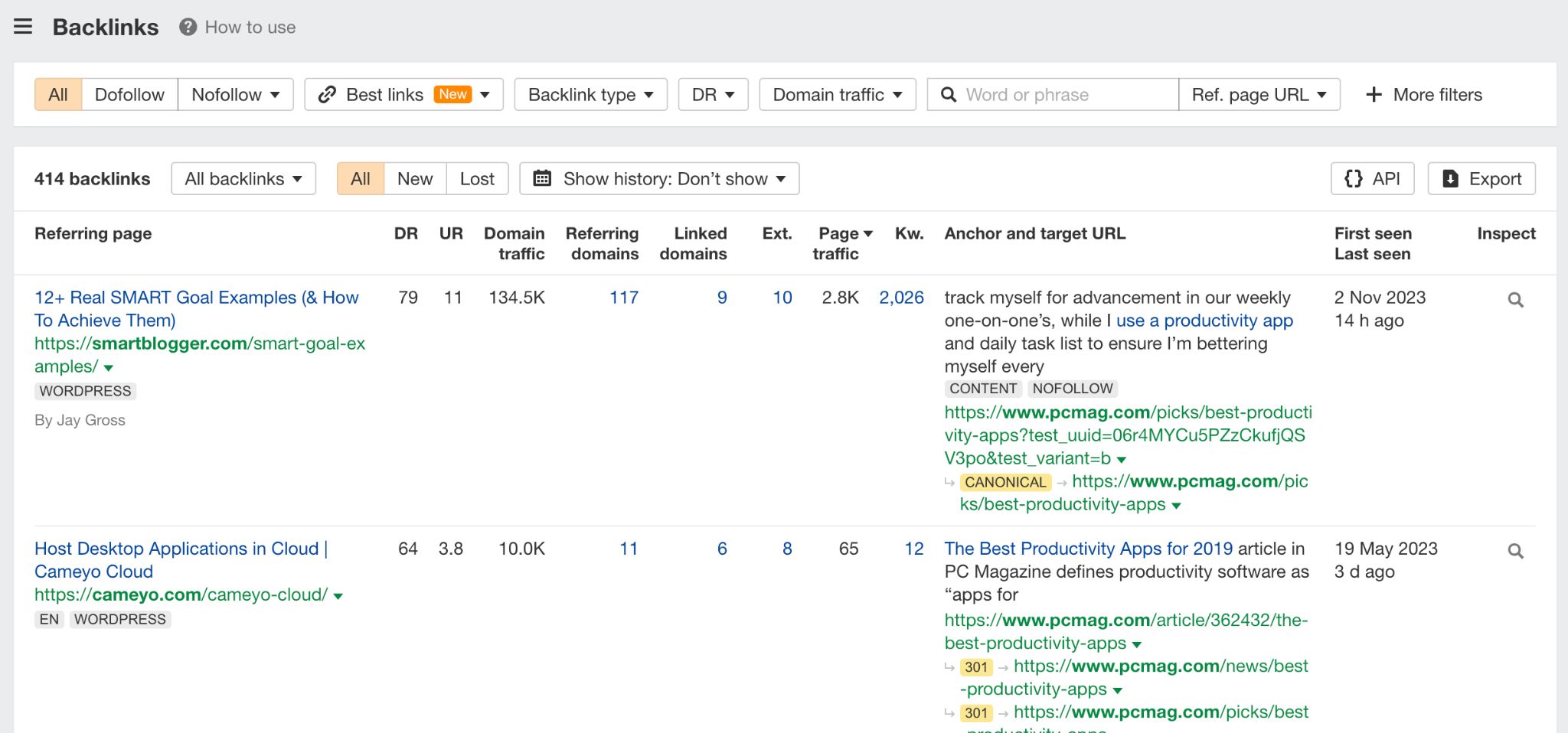

From that point, the typical process involves identifying sites with the highest potential to boost your SEO and contacting their owners if you think they’d be willing to link to your content. We’re covering the details of this process and everything else you need to know to start with link building in this guide.
4. Avoid common keyword pitfalls
Four big don’ts of using keywords.
- Don’t use the same keyword excessively on a page. Repeating a keyword too frequently within a single page can lead to keyword stuffing, which is treated as spam by Google.
- Don’t use the same focus keyword across multiple pages. Each page on your website should have a unique focus keyword. Using the same keyword across multiple pages can lead to keyword cannibalization, where pages compete against each other in search results.
- Don’t sacrifice quality content for keyword usage. While keywords are essential for SEO, prioritize high-quality, informative content above all else. Don’t make your content read unnatural or too long by cramming in keywords. This won’t help you rank and will decrease content quality.
- Don’t use keywords just for the sake of using them. This means two things. First, don’t target keywords not related to your website or business — this will only bring you useless traffic. Second, don’t try to hit some keyword frequency goal which is often suggested by content optimization tools by just mentioning the keyword without any substance — SEO doesn’t work that way anymore.
Final thoughts
This article focused on general SEO for text-based content. For using keywords in other types of content and SEO, see these guides:
SEO
Google Launches New ‘Saved Comparisons’ Feature For Analytics

Google announced a new tool for Analytics to streamline data comparisons.
The ‘saved comparisons’ feature allows you to save filtered user data segments for rapid side-by-side analysis.
Google states in an announcement:
“We’re launching saved comparisons to help you save time when comparing the user bases you care about.
Learn how you can do that without recreating the comparison every time!”
We’re launching saved comparisons to help you save time when comparing the user bases you care about. Learn how you can do that without recreating the comparison every time! → https://t.co/29nN2MiPtm pic.twitter.com/r8924rAT05
— Google Analytics (@googleanalytics) May 8, 2024
Google links to a help page that lists several benefits and use cases:
“Comparisons let you evaluate subsets of your data side by side. For example, you could compare data generated by Android devices to data generated by iOS devices.”
“In Google Analytics 4, comparisons take the place of segments in Universal Analytics.”
Saved Comparisons: How They Work
The new comparisons tool allows you to create customized filtered views of Google Analytics data based on dimensions like platform, country, traffic source, and custom audiences.
These dimensions can incorporate multiple conditions using logic operators.
For example, you could generate a comparison separating “Android OR iOS” traffic from web traffic. Or you could combine location data like “Country = Argentina OR Japan” with platform filters.
These customized comparison views can then be saved to the property level in Analytics.
Users with access can quickly apply saved comparisons to any report for efficient analysis without rebuilding filters.
Google’s documentation states:
“As an administrator or editor…you can save comparisons to your Google Analytics 4 property. Saved comparisons enable you and others with access to compare the user bases you care about without needing to recreate the comparisons each time.”
Rollout & Limitations
The saved comparisons feature is rolling out gradually. There’s a limit of 200 saved comparisons per property.
For more advanced filtering needs, such as sequences of user events, Google recommends creating a custom audience first and saving a comparison based on that audience definition.
Some reports may be incompatible if they don’t include the filtered dimensions used in a saved comparison. In that case, the documentation suggests choosing different dimensions or conditions for that report type.
Why SEJ Cares
The ability to create and apply saved comparisons addresses a time-consuming aspect of analytics work.
Analysts must view data through different lenses, segmenting by device, location, traffic source, etc. Manually recreating these filtered comparisons for each report can slow down production.
Any innovation streamlining common tasks is welcome in an arena where data teams are strapped for time.
How This Can Help You
Saved comparisons mean less time getting bogged down in filter recreation and more time for impactful analysis.
Here are a few key ways this could benefit your work:
- Save time by avoiding constant recreation of filters for common comparisons (e.g. mobile vs desktop, traffic sources, geo locations).
- Share saved comparisons with colleagues for consistent analysis views.
- Switch between comprehensive views and isolated comparisons with a single click.
- Break down conversions, engagement, audience origins, and more by your saved user segments.
- Use thoughtfully combined conditions to surface targeted segments (e.g. paid traffic for a certain product/location).
The new saved comparisons in Google Analytics may seem like an incremental change. However, simplifying workflows and reducing time spent on mundane tasks can boost productivity in a big way.
Featured Image: wan wei/Shutterstock
-
SEARCHENGINES5 days ago
Daily Search Forum Recap: May 3, 2024
-

 MARKETING5 days ago
MARKETING5 days agoHow Tagging Strategies Transform Marketing Campaigns
-

 MARKETING7 days ago
MARKETING7 days agoLet’s Start Treating Content More Like We Treat Code
-

 MARKETING6 days ago
MARKETING6 days agoTinuiti Recognized in Forrester Report for Media Management Excellence
-

 WORDPRESS6 days ago
WORDPRESS6 days agoThe Top 5 AI-Powered Tools for WordPress Creatives – WordPress.com News
-

 PPC6 days ago
PPC6 days agoStandard Performance Max vs Performance Max for Retail
-

 SEO6 days ago
SEO6 days agoGoogle Performance Max For Marketplaces: Advertise Without A Website
-

 SEARCHENGINES4 days ago
SEARCHENGINES4 days agoThe Industry Mourns The Loss Of Mark Irvine















